Modern concrete floors have evolved far beyond their industrial origins to become sophisticated design statements in contemporary living spaces. These versatile surfaces offer durability, energy efficiency, and endless aesthetic possibilities that complement various interior styles from minimalist to maximalist. Today's concrete floor solutions provide homeowners with practical benefits including easy maintenance, excellent thermal properties, and the ability to serve as a neutral foundation for creative decorating approaches. Whether you're building new or renovating existing spaces, concrete floors offer cost-effective luxury that can dramatically transform your living room's atmosphere while maintaining functionality for daily family life.
1. Polished Concrete Floor Living Room with Neutral Elegance
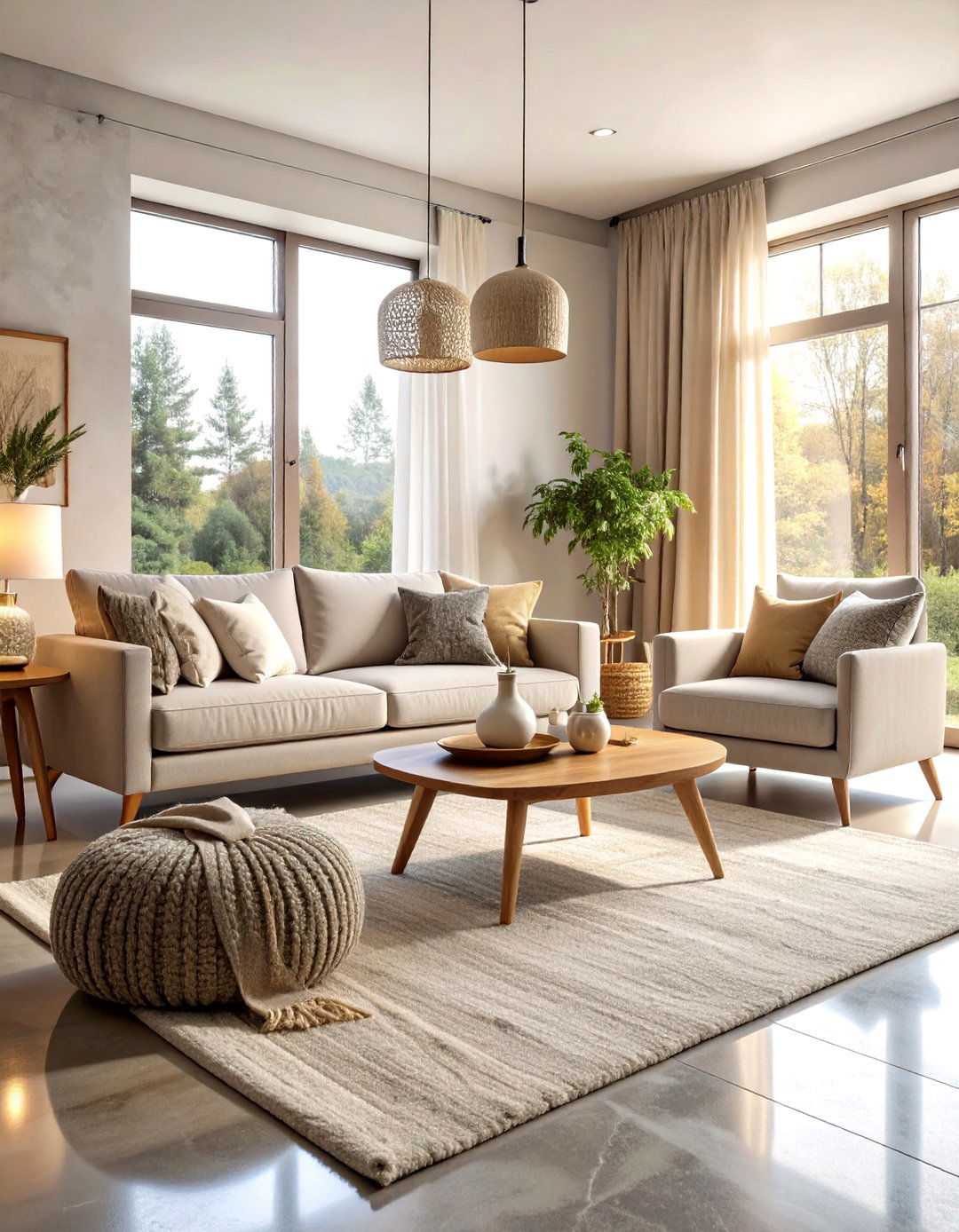
Polished concrete offers endless possibilities for decorating your living room, creating a sophisticated foundation that pairs beautifully with neutral color palettes. This concrete floor living room approach emphasizes clean lines and understated luxury through carefully curated furnishings in whites, grays, and beiges. The reflective surface of polished concrete enhances natural light distribution throughout the space, making rooms appear larger and brighter. When you go with neutrals for the big items, like sofas, armchairs and ottomans, then go a bit bold with decorative accessories—that way, you can easily swap out the small things when a new color scheme is in order. Consider adding texture through linen throws, wool cushions, and natural fiber rugs to soften the inherent coolness of polished concrete while maintaining the sophisticated aesthetic.
2. Exposed Aggregate Concrete Floor Living Room with Natural Stone Appeal
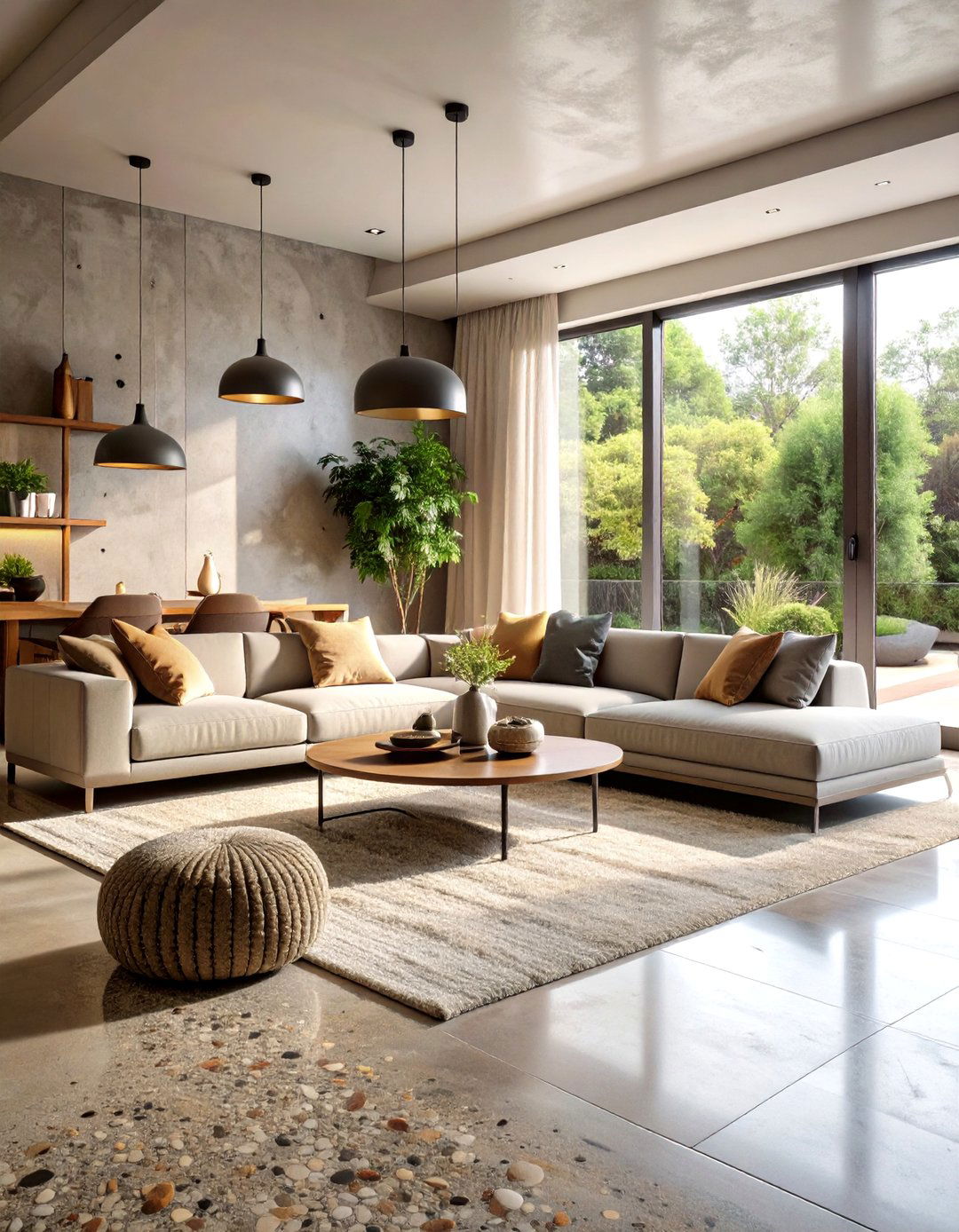
Transform your space with exposed aggregate concrete floor living room designs that showcase natural stone beauty. Exposed aggregate concrete is accomplished by pouring then removing the top layer, uncovering the coarse aggregate beneath, creating a beautiful, natural, salt-and-pepper terrazzo effect. This technique reveals decorative stones, pebbles, or recycled materials embedded within the concrete, creating unique textural patterns that mimic expensive terrazzo or granite surfaces. You can have the look of terrazzo without the cost of terrazzo, with exposed aggregate floors being some of the most unique in the flooring industry. The varied surface provides natural slip resistance and helps disguise everyday wear patterns, making it ideal for high-traffic family living rooms where durability meets sophisticated design aesthetics.
3. Stained Concrete Floor Living Room with Warm Earth Tones
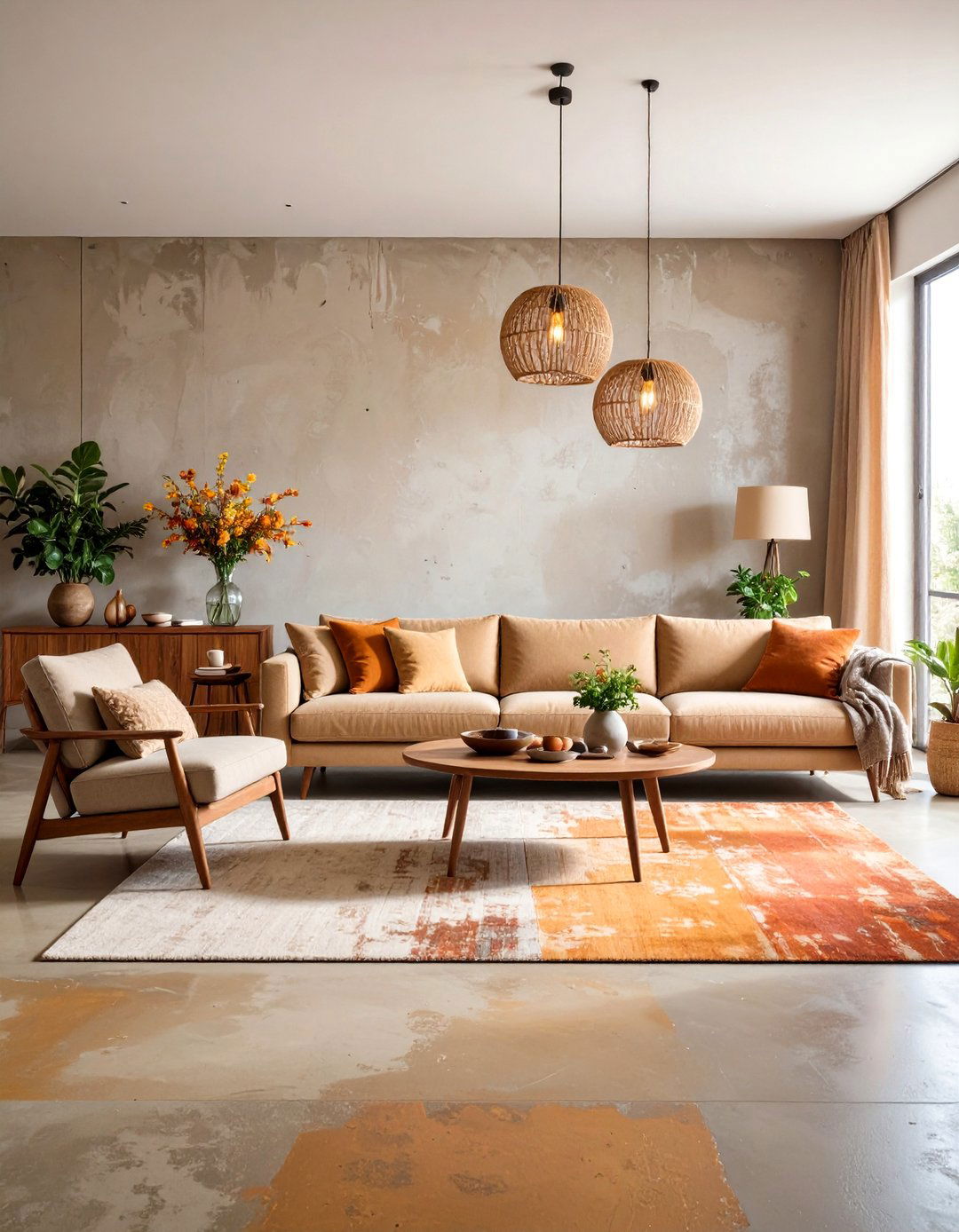
Applying a stain during the finishing process helps blend areas and creates custom-blended effects that emphasize the natural characteristics and richness of the slab. Stained concrete floor living room designs offer unlimited color possibilities, from subtle earth tones to rich jewel-like hues that complement various decorating styles. The staining process penetrates deep into the concrete surface, creating permanent coloration that won't chip or fade with normal use. Consider warm amber, terra cotta, or sage green stains to create inviting atmospheres that make concrete feel less industrial and more residential. The variegated colors, hairline cracks and uneven patterns tell a meaningful story while providing a wonderful contrast that captures hand-in-glove relationship of natural influence and modern design.
4. Radiant Heated Concrete Floor Living Room for Ultimate Comfort
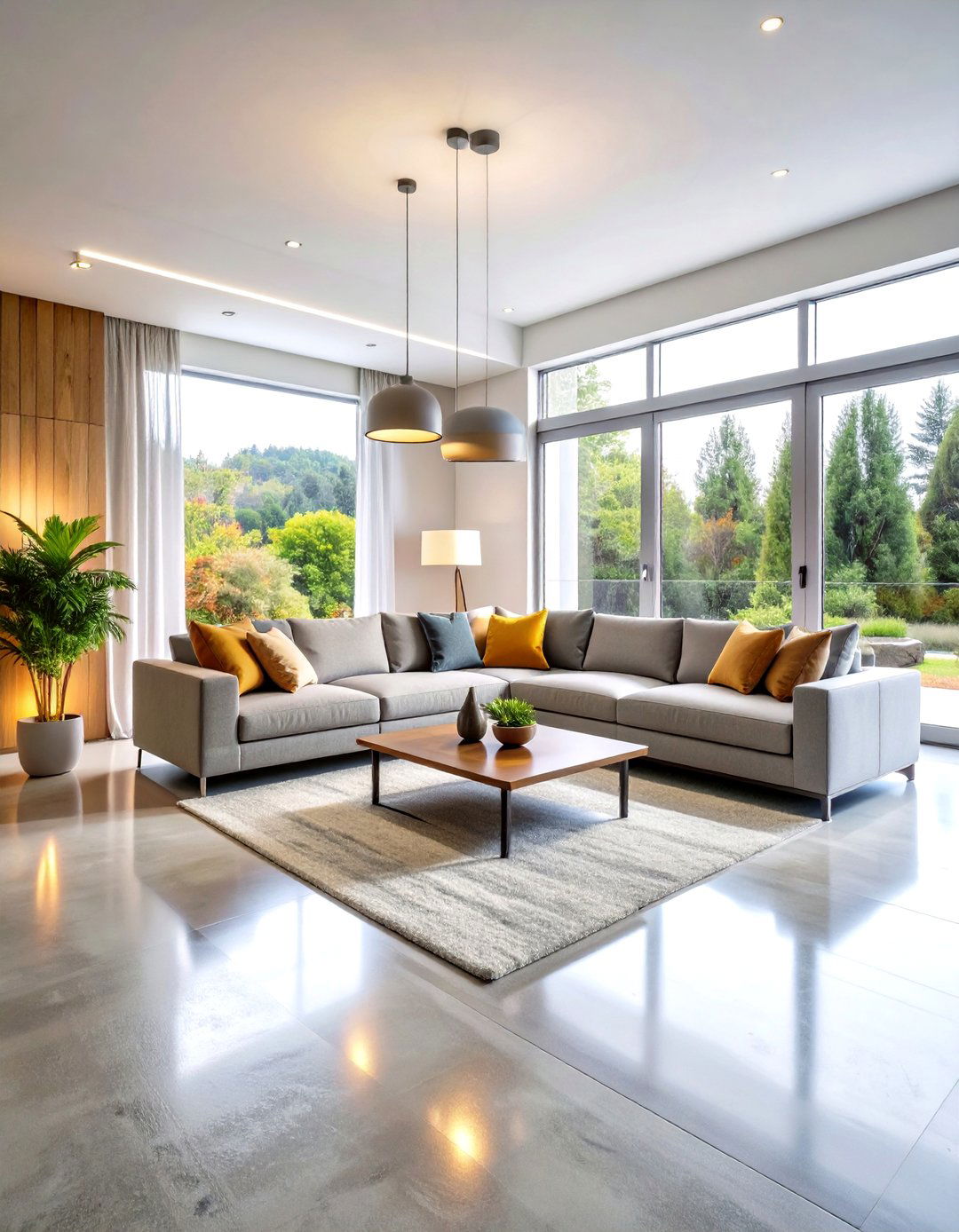
Due to their high thermal-mass, concrete floors are ideal to be heated by an underfloor heating system, providing quick heat-up times and retaining heat well. Radiant heated concrete floor living room installations eliminate the cold, hard sensation traditionally associated with concrete surfaces. The thermal mass of the concrete turns into an inconspicuous radiator of warm, even heat, consuming less energy to achieve the same level of comfort. These systems operate silently and invisibly, providing consistent warmth from the ground up without visible heating elements cluttering your design. Heated polished concrete floors can reduce heating costs by 25 to 50 percent compared to traditional heating systems. The combination of comfort and efficiency makes radiant heating an excellent investment for concrete floor living rooms in any climate.
5. Industrial Modern Concrete Floor Living Room with Metal Accents
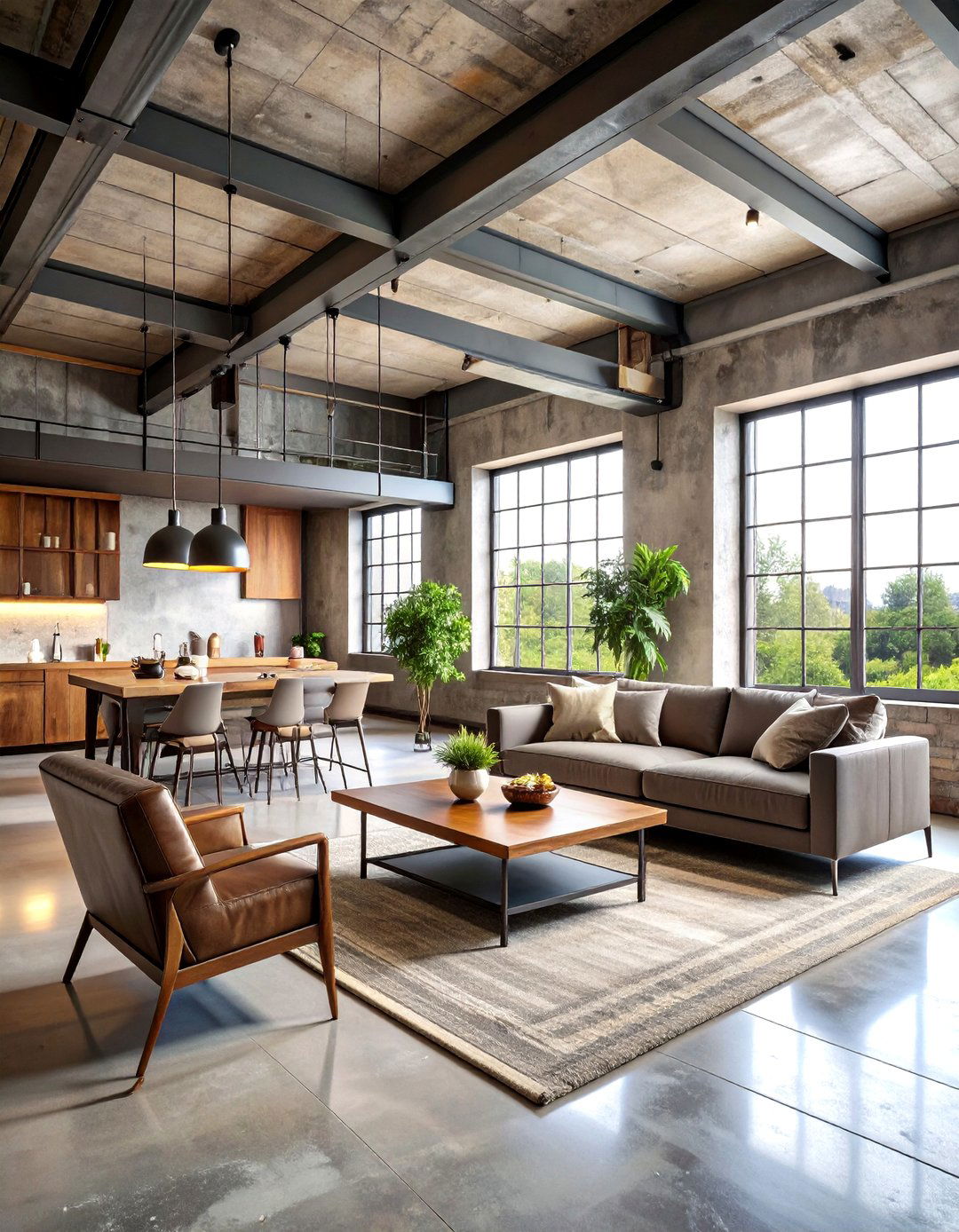
Industrial style open concept concrete floor living room designs celebrate raw materials and architectural honesty. This concrete floor living room approach embraces exposed structural elements, incorporating steel beams, metal ductwork, and industrial lighting fixtures to create authentic urban loft aesthetics. The concrete floor serves as the perfect neutral foundation for showcasing vintage industrial furniture, metal coffee tables, and Edison bulb lighting installations. In this living room, it was decided to reveal the raw concrete ceiling and put in industrial, transparent metal bedroom doors, creating balance between cold, mineral materials and warm woodwork. Steel and iron accessories, along with leather furniture and vintage industrial artifacts, complete the look while maintaining the sophisticated edge that defines contemporary industrial design.
6. Concrete Floor Living Room Paired with Wood Accent Walls
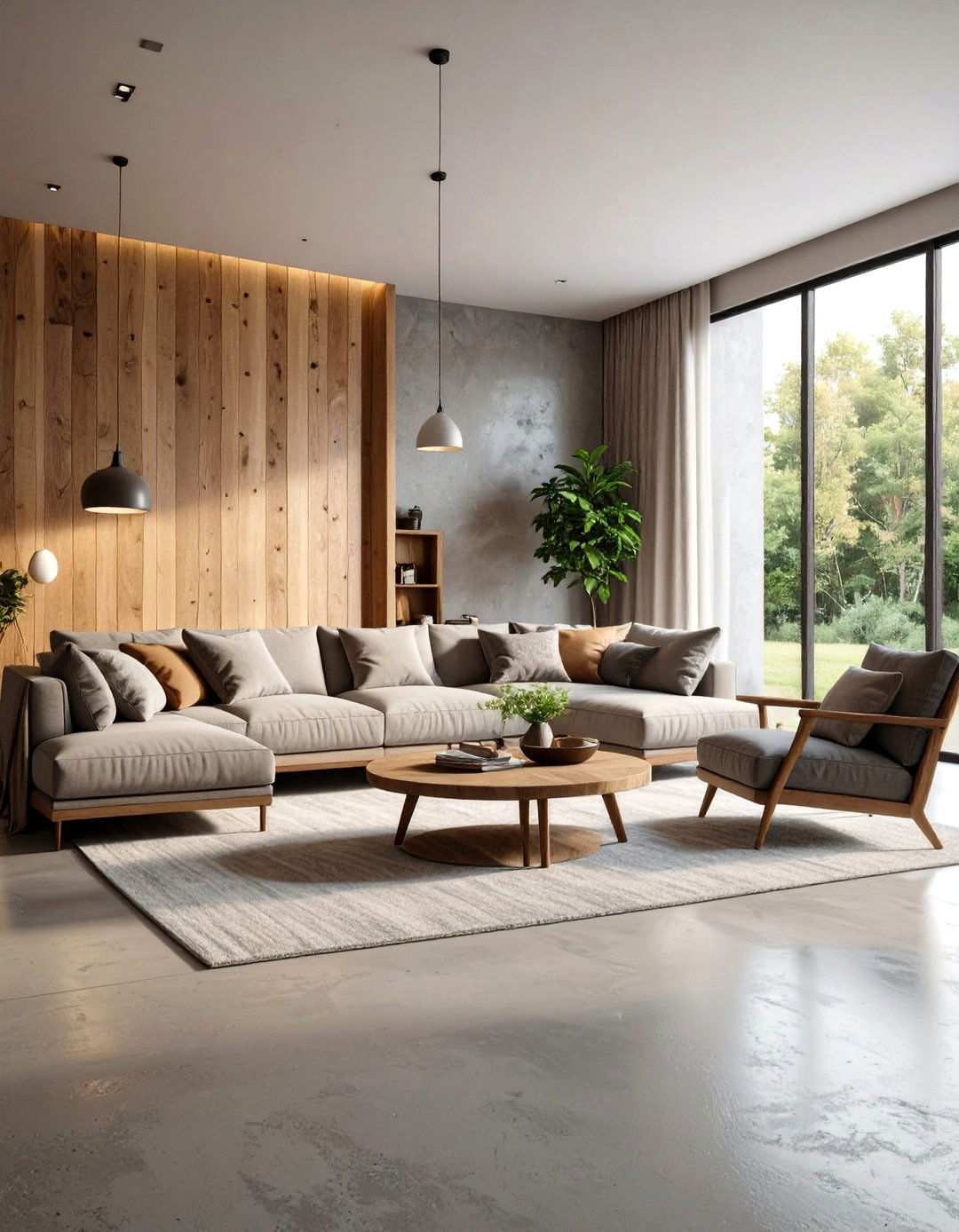
The combination of wood and concrete, two materials that complement each other beautifully, creates a pattern that emerges throughout successful designs. This concrete floor living room concept balances the cool, modern appeal of concrete with the warmth and natural texture of wood accent features. Cornerstone Architects combined a polished concrete floor with a wood-clad accent wall and neutral-colored furniture to give the living room a warm and cozy ambiance while keeping the decor simple. Consider installing reclaimed barn wood, cedar planks, or walnut panels on feature walls to create visual warmth that softens concrete's industrial character. Natural timber tones go well with concrete's neutral shades, while adding depth to bolder colors when planning an urban organic-inspired space.
7. Minimalist Concrete Floor Living Room with Layered Textiles

MaRae loves to layer – put rugs on top of rugs, throws on top of throws for the layering effect. This concrete floor living room approach uses strategic textile placement to create warmth and comfort while maintaining clean, minimalist aesthetics. High piles of shag and wool rugs not only add coziness but also provide a softer feel underfoot, overcoming the inherent disadvantages of concrete floors. Layer different textures through area rugs, throw pillows, blankets, and curtains to introduce visual interest and tactile comfort. Choose natural fibers like wool, linen, and cotton in neutral tones to maintain the minimalist approach while ensuring your concrete floor living room feels inviting rather than stark. The key lies in balancing the raw concrete foundation with carefully curated soft furnishings.
8. Biophilic Concrete Floor Living Room with Natural Elements
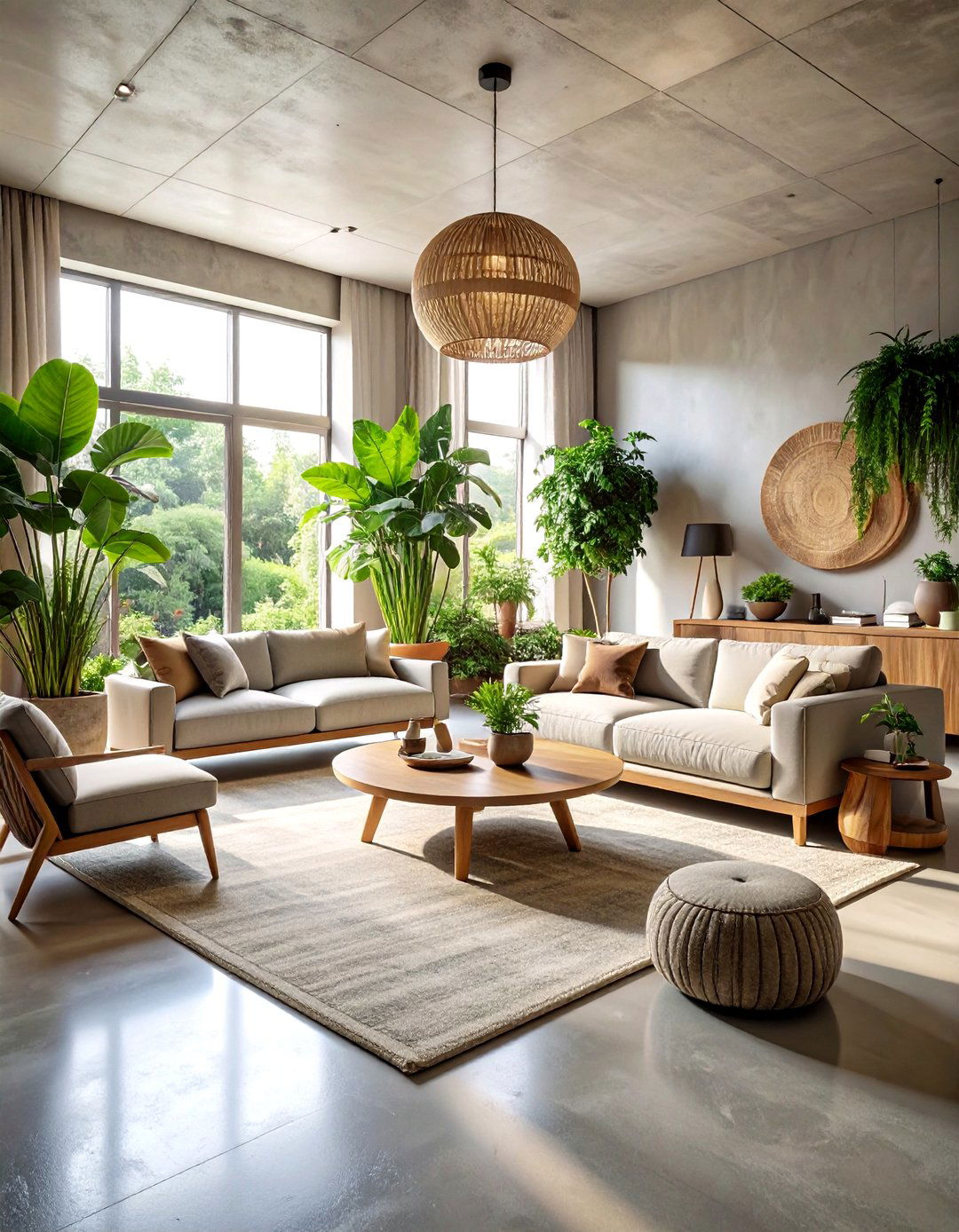
Living plants are must-haves in urban organic-inspired spaces, bringing the outside in even when projects don't have floor-to-ceiling glazing. This concrete floor living room design philosophy integrates natural elements to create healthier, more balanced living environments. Biophilic design, which incorporates natural elements into interior spaces, continues to gain popularity in 2025 living room trends. Include large potted plants, natural stone accents, and organic shapes to soften concrete's geometric nature. Polished concrete pots can bring a minimalist, industrial vibe to your living room when paired with plants to create a captivating contrast between natural greenery and industrial charm. Consider installing living walls, incorporating natural wood furniture, and maximizing natural light to create seamless indoor-outdoor connections that enhance well-being.
9. Microcement Concrete Floor Living Room for Seamless Finishes
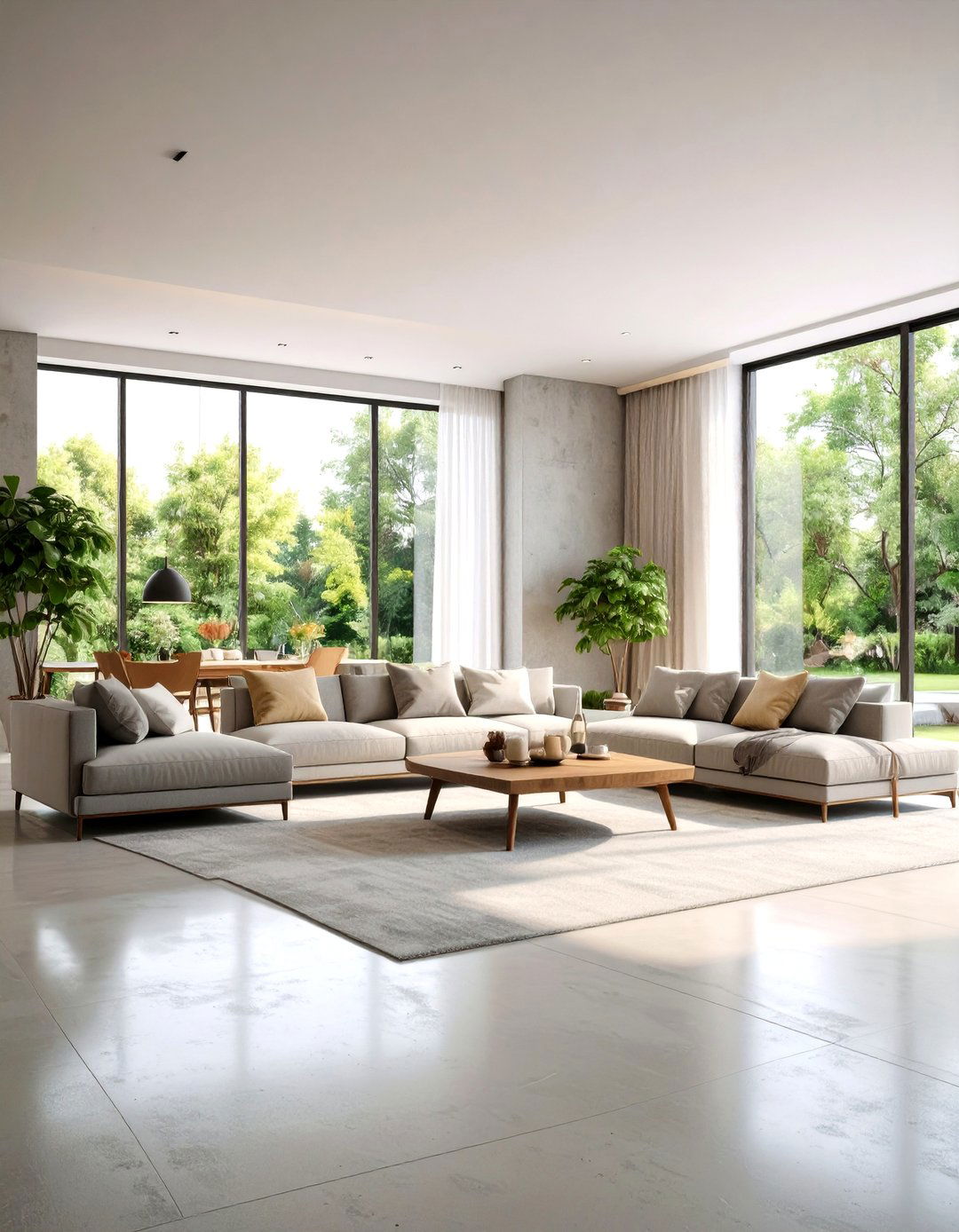
Microcement is an ideal background for interesting minimalist details and provides seamless, elegant surfaces with quick installation. This concrete floor living room technique offers the aesthetic appeal of concrete without the thickness and weight of traditional poured concrete. For upper floors, an alternative like microcement is more practical than traditional poured concrete. Microcement applications create continuous surfaces that flow seamlessly from floors to walls, eliminating grout lines and transition strips for ultra-modern aesthetics. The walls and floor covered with microcement combine well with additions from natural materials, creating a cozy interior. This versatile material accommodates underfloor heating systems and provides excellent durability while maintaining a sophisticated, spa-like atmosphere perfect for contemporary living spaces seeking understated luxury.
10. Statement Lighting Concrete Floor Living Room Designs
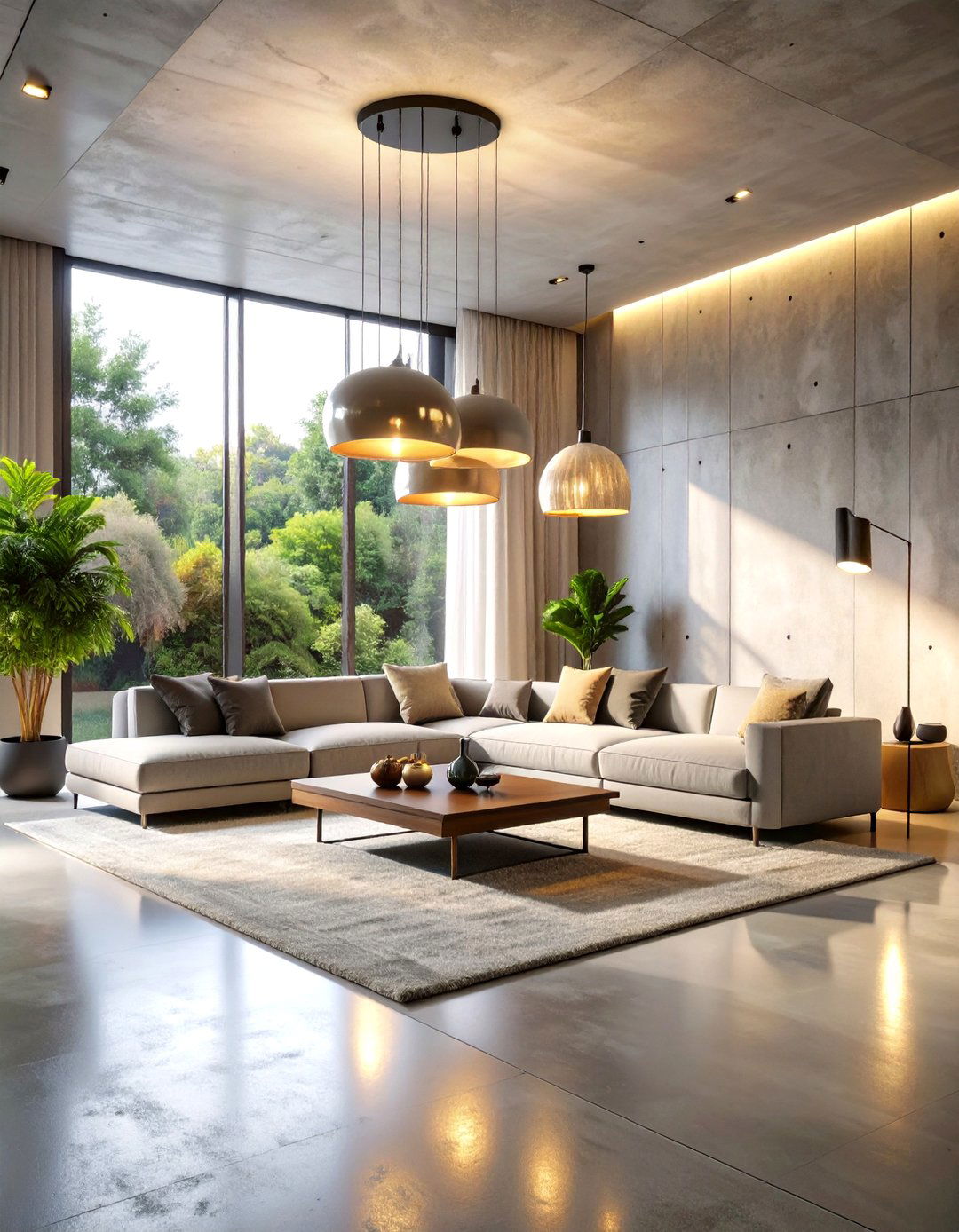
Statement fixtures and layered lighting are in for 2025, with architectural lighting in the form of sconces, chandeliers, and sculptural floor lamps replacing purely functional lighting. This concrete floor living room approach uses dramatic lighting installations as primary design elements. Lighting is an important feature to consider when decorating concrete floor living rooms, whether through overhead lighting or table and floor lamps that become design features themselves. The neutral backdrop of concrete floors allows bold lighting fixtures to take center stage without visual competition. Lighting gives the interior a unique atmosphere, warming spaces and making us want to stay, with beautiful hanging and floor lamps made of concrete. Consider oversized pendant lights, architectural track lighting, or custom concrete light fixtures to create focal points while providing functional illumination.
11. Scandinavian-Style Concrete Floor Living Room with Cozy Elements
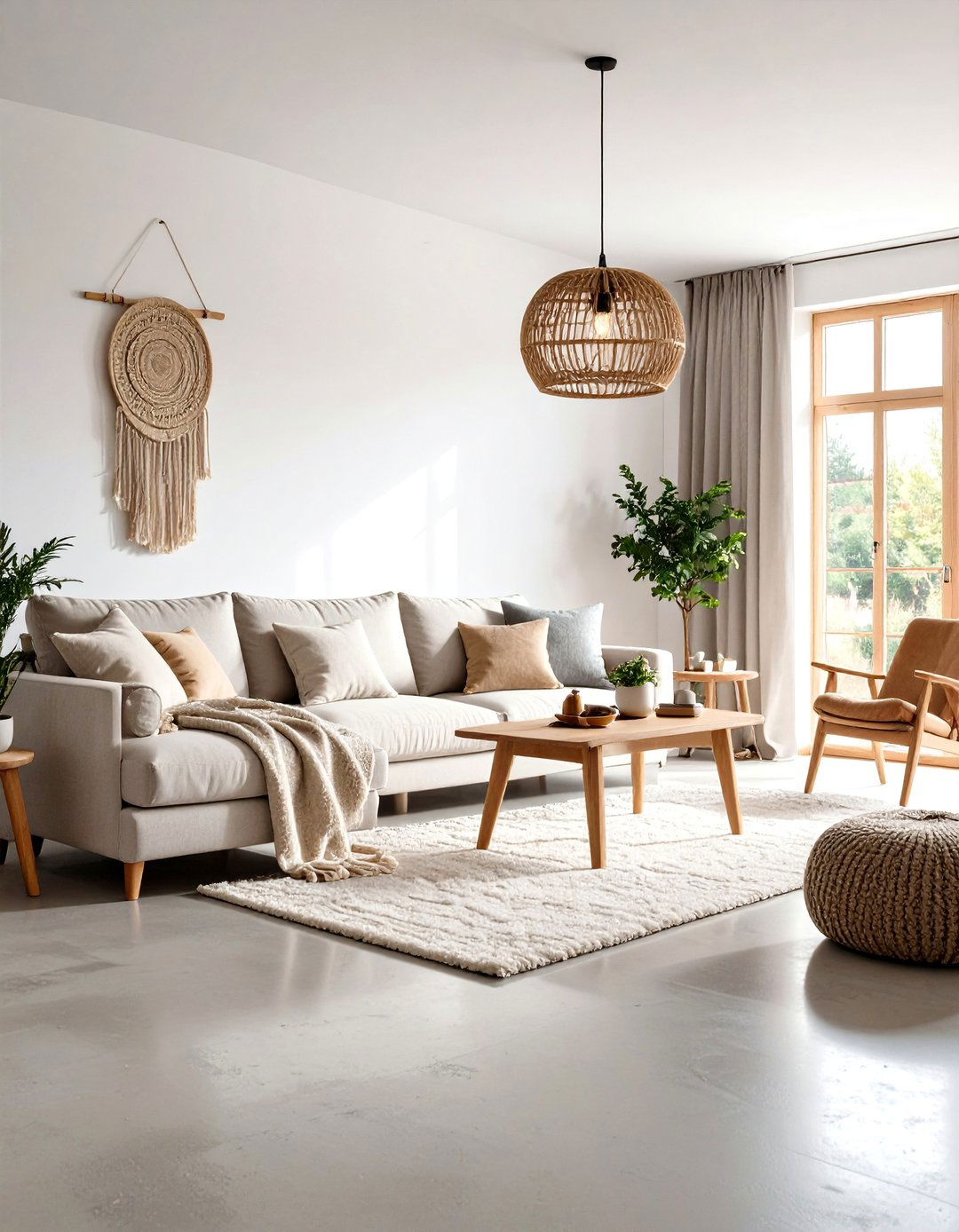
In 2025 interior design trends, comfort is king, with plush sofas, oversized cushions, and cozy blankets uplifting and marking inviting spaces. This concrete floor living room style combines Nordic minimalism with hygge comfort principles. The approach of Isern Associats shows how the contrast between polished concrete floors and wood-clad walls can be subtle, providing texture without overwhelming warmth for minimalist and Nordic-inspired decors. Incorporate light woods, white and cream furnishings, and plenty of soft textiles to create that coveted Scandinavian atmosphere. Wool rugs, with their softness and durability, are the best rugs for concrete floors, seamlessly complementing the authenticity of hard flooring while adding Nordic warmth. Focus on functionality, natural materials, and creating cozy gathering spaces that celebrate both form and comfort.
12. Contemporary Concrete Floor Living Room with Bold Furniture Statements
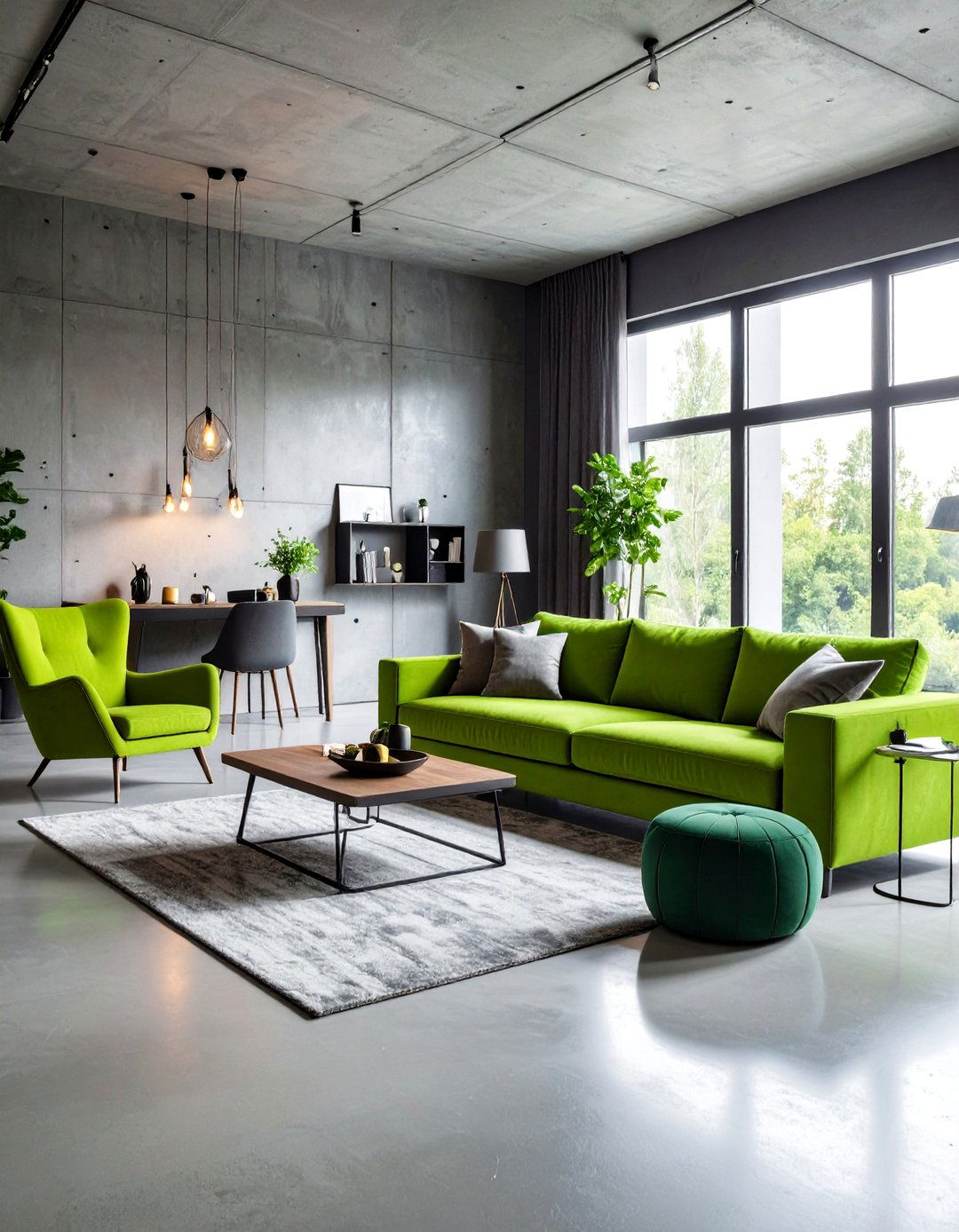
In 2025, we see a shift from minimalism to maximalism, embracing vibrant jewel tones like deep greens, purples, and golds. This concrete floor living room approach uses the neutral concrete foundation as a backdrop for dramatic furniture pieces and bold color choices. We absolutely love the bright green sofa and matching ottoman, not to mention all those gorgeous throw pillows, showing how concrete floors make the most of bold statements. The inherent neutrality of concrete allows you to experiment with striking furniture pieces, colorful artwork, and dramatic accessories without overwhelming the space. If you want your sofa to be a statement piece then scale back other decor so they don't fight for attention. Consider curved sofas, bold geometric coffee tables, and vibrant accent pieces that pop against the understated concrete backdrop.
13. Built-in Seating Concrete Floor Living Room Concepts
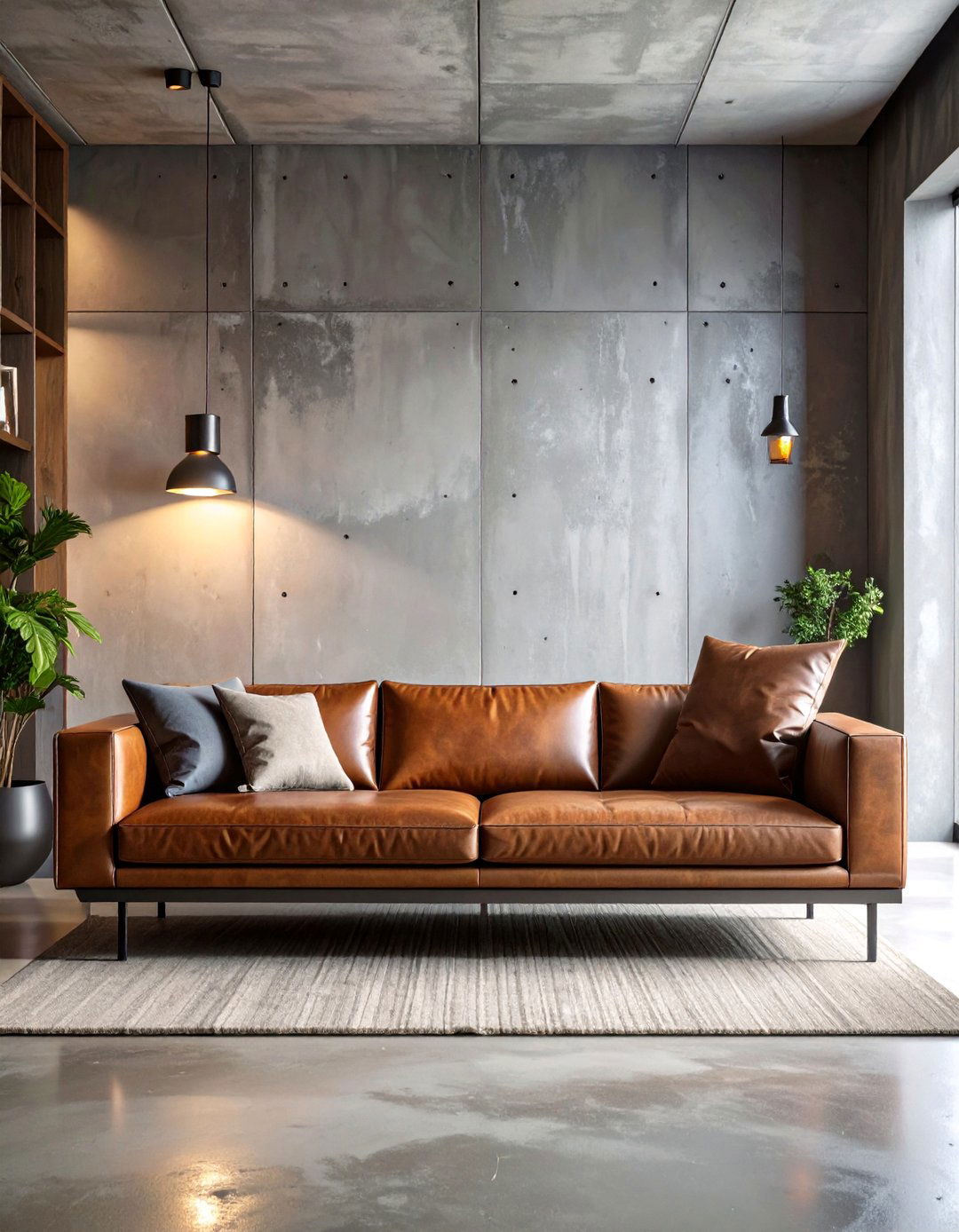
Custom cabinetry and built-in seating provide space for wall-mounted TVs and collections while concealing electronic components. This concrete floor living room design maximizes functionality through integrated seating solutions that complement the concrete's architectural character. Built-ins are the best way to accommodate storage needs since they take up less space and are often customized to meet your specific requirements. Consider concrete built-in benches with integrated storage, window seat reading nooks, or custom banquettes that echo the material continuity throughout the space. The brown leather upholstery on the L-shaped bench balanced out concrete elements, showing how built-in seating can create warm, cozy living spaces. These permanent fixtures provide both practical seating and architectural interest while maintaining the clean lines that complement concrete floors.
14. Artistic Raw Concrete Floor Living Room Installations
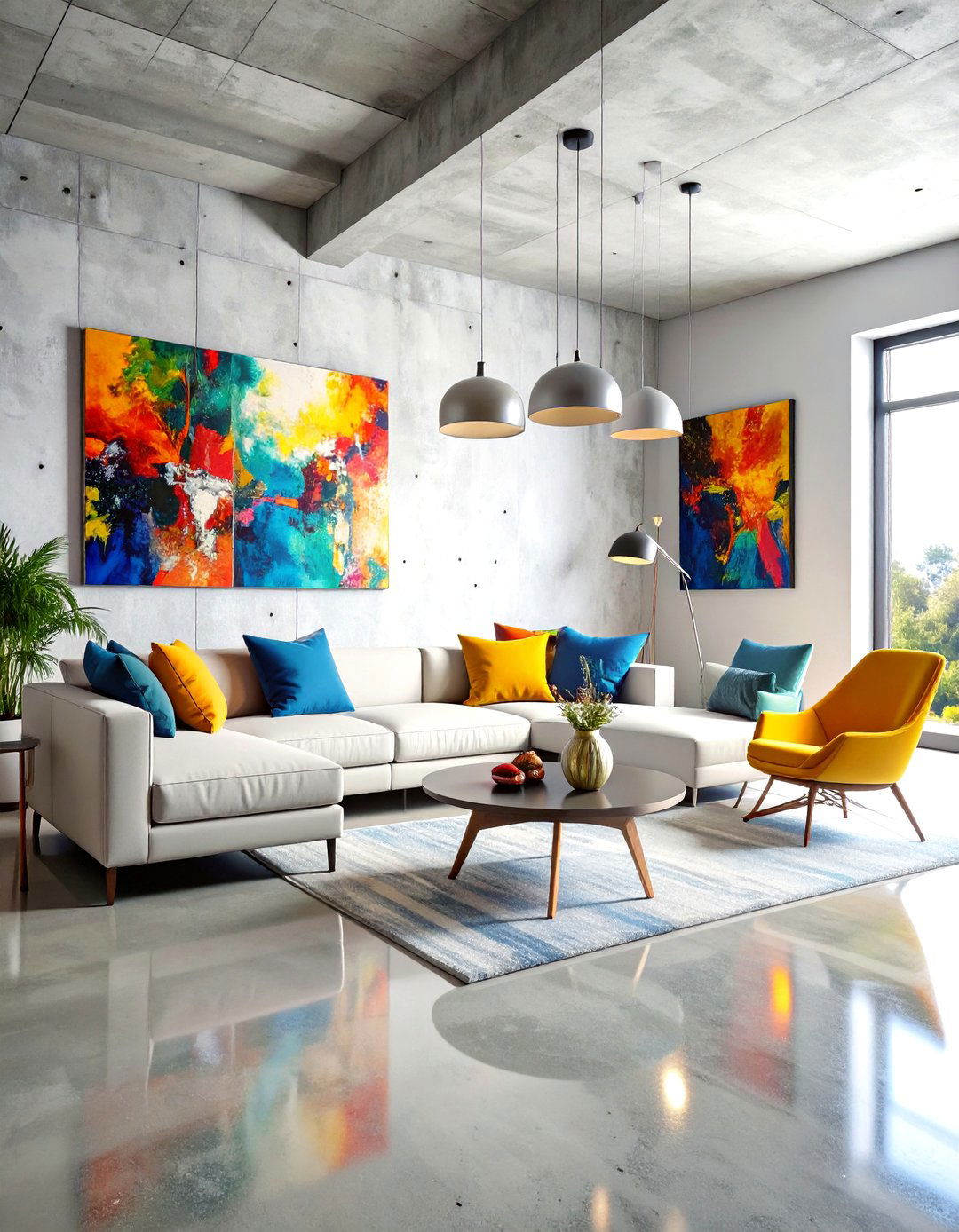
The roughness of concrete in the living room has been softened by rugs, fireplaces and works of art, showing how concrete walls and floors provide the backdrop for bold custom furniture. This concrete floor living room concept celebrates concrete's raw, unfinished beauty as an artistic medium itself. Japanese-inspired spirit carries throughout homes in the form of furnishings, art and finishes, where 'wabi-sabi' embraces the perfectly imperfect. Leave concrete surfaces intentionally rough or textured to create gallery-like atmospheres that showcase artwork, sculptures, and architectural details. A warm charcoal concrete floor creates a gallery-like feel that emphasizes artwork, sculpture and décor. The monochromatic foundation allows colorful art pieces and sculptural elements to command attention while the concrete's honest material expression adds authenticity and character to contemporary living spaces.
15. Glass and Steel Concrete Floor Living Room Combinations
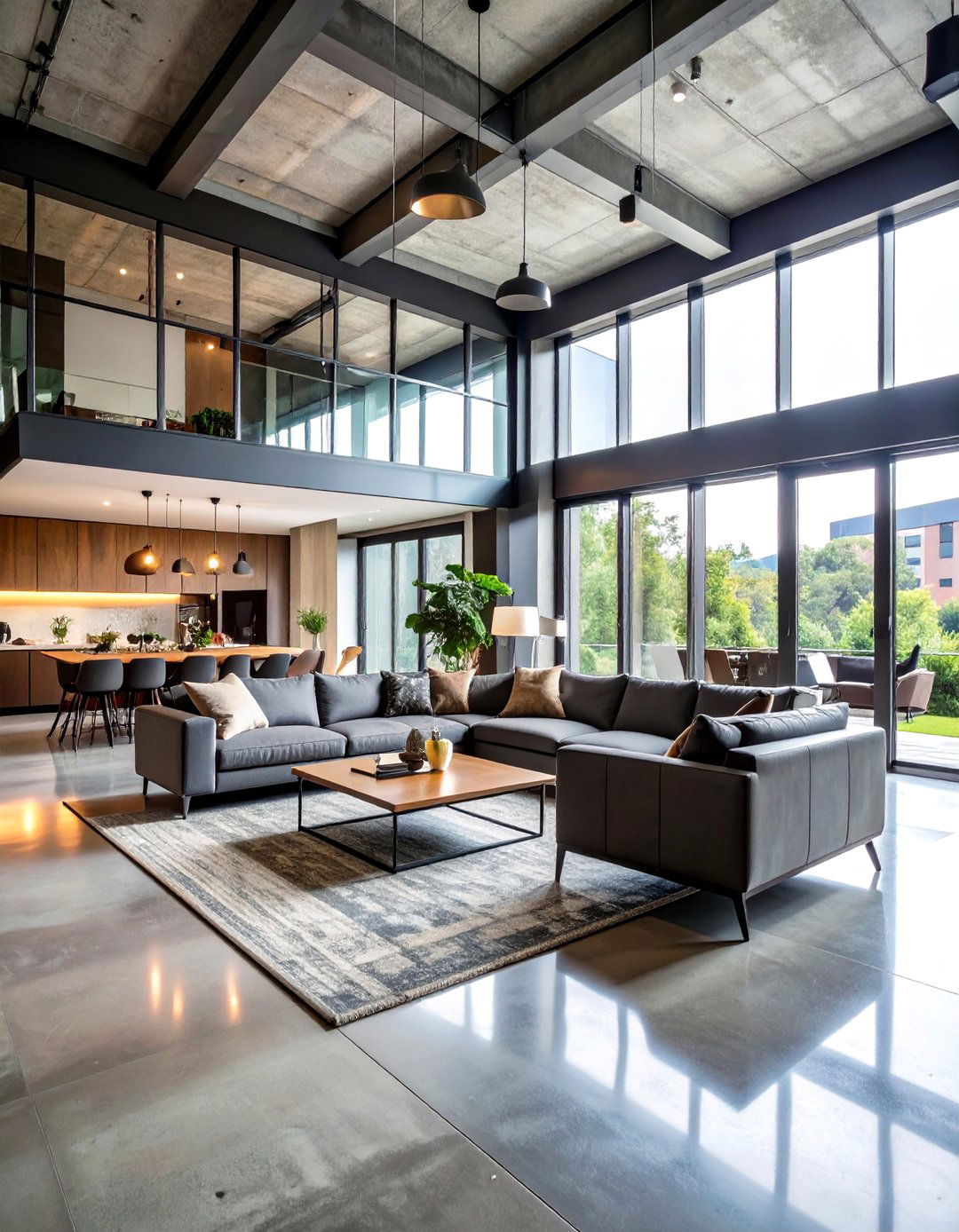
The Heavy Metal Residence combines glass, steel and concrete to capture the beauty of the rugged landscape and translate it into modern architecture. This concrete floor living room design celebrates industrial materials through sophisticated combinations of concrete, steel, and glass elements. Views of solar panels installed on glass ceilings and sliding wood doors demonstrate how concrete floors complement high-tech architectural features. Incorporate floor-to-ceiling glass walls, steel beam accents, and metal furniture pieces to create cohesive material palettes. The space is balanced between cold, mineral materials such as concrete, metal and glass, and warm woodwork and light textiles. These material combinations work particularly well in loft-style spaces or contemporary homes where architectural honesty and material transparency create sophisticated, urban-inspired living environments.
16. Mid-Century Modern Concrete Floor Living Room Revival
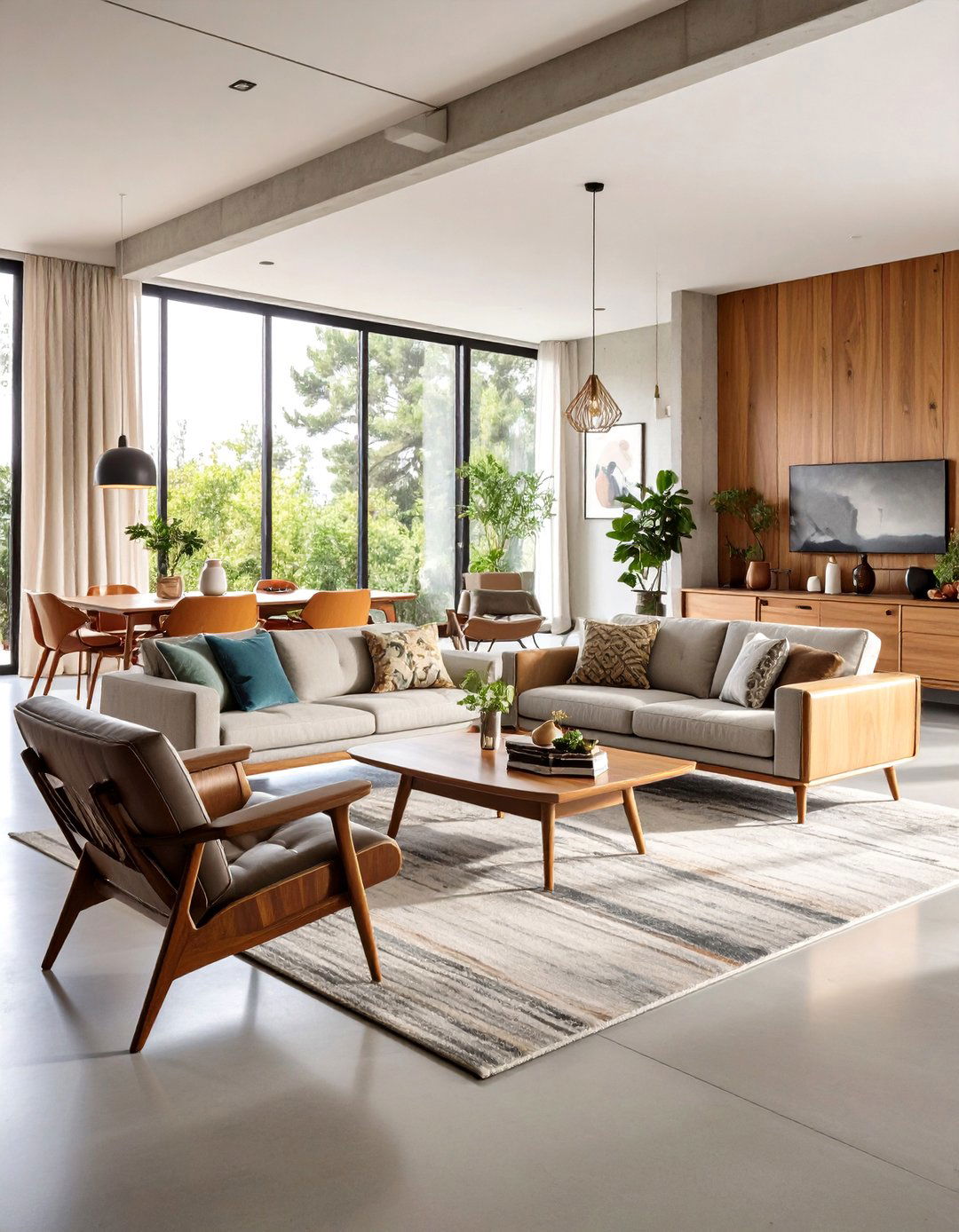
This meticulously restored Gregory Ain home in Los Angeles showcases the timeless elegance of mid-century modern architecture with concrete floors and original features. This concrete floor living room style honors mid-century design principles while incorporating contemporary comfort and technology. The living room is furnished with a mix of mid-century modern classics and contemporary pieces, including plush brown sofas, woven accent chairs, and iconic furniture pieces. Focus on clean lines, geometric patterns, and period-appropriate furniture silhouettes that complement concrete's modernist origins. Mid Century Modern aesthetics can sometimes lean toward cold feelings, but introducing nonuniform, organic surfaces makes spaces feel more inviting and grounded. Incorporate vintage Eames chairs, Nelson benches, and period lighting fixtures to create authentic mid-century atmospheres enhanced by concrete's inherent modernist appeal.
17. Geometric Pattern Concrete Floor Living Room Designs
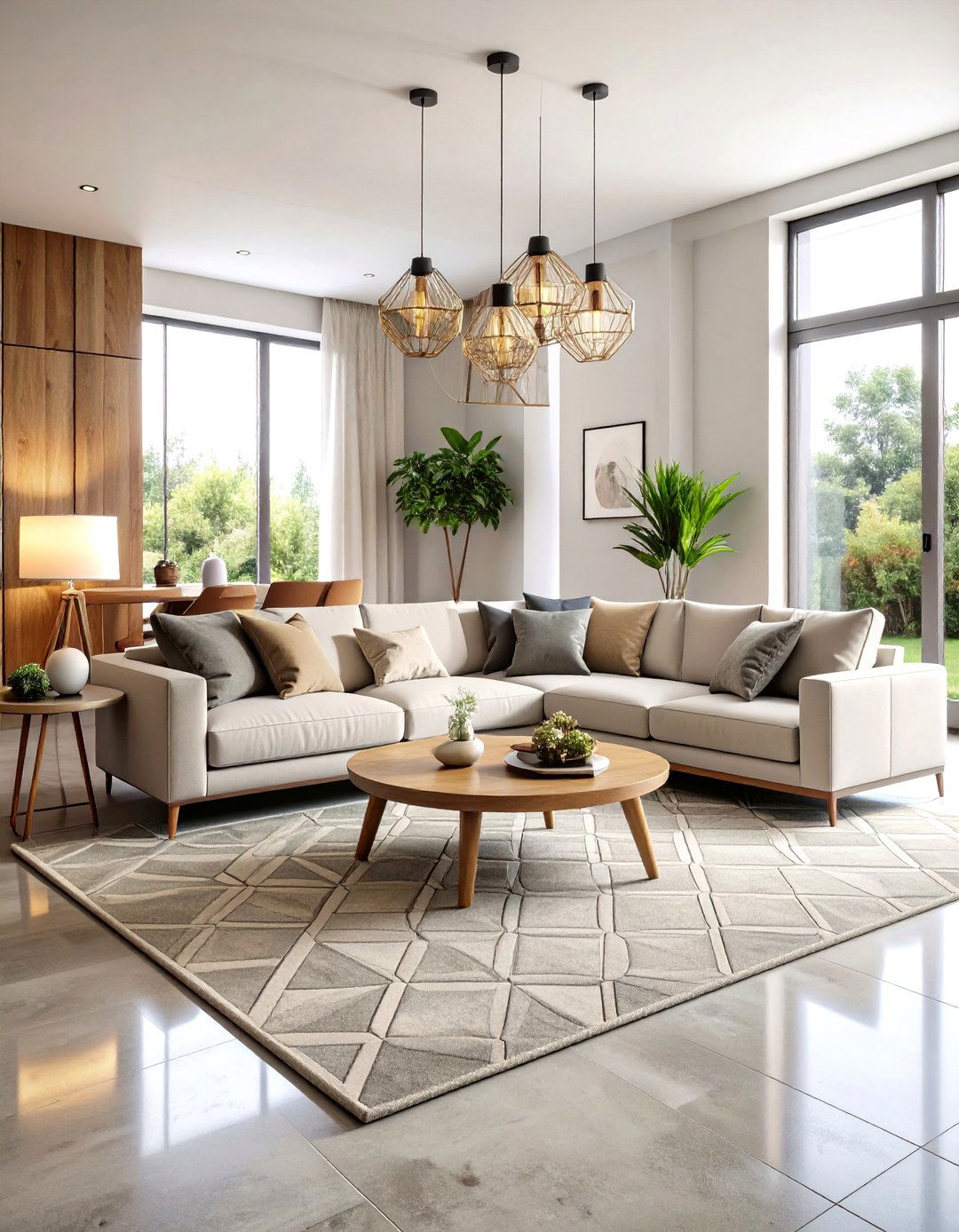
Large-format tiles and geometric patterns are having a moment, with checkerboard designs and bold patterns making big impressions in 2025. This concrete floor living room approach incorporates geometric patterns through inlays, scoring, or decorative treatments that add visual interest to plain concrete surfaces. You can combine exposed aggregate in bands or fields separated by joints, wood divider strips, or bands of contrasting decorative treatments. Consider diamond patterns, hexagonal inlays, or linear scoring that creates sophisticated geometric compositions. Stenciling offers reusable urethane stencils as a simple and easy way to add intricate designs to concrete surfaces. These decorative techniques transform basic concrete into distinctive design statements while maintaining the material's inherent durability and low-maintenance characteristics perfect for busy family living rooms.
18. Eco-Friendly Concrete Floor Living Room with Sustainable Materials
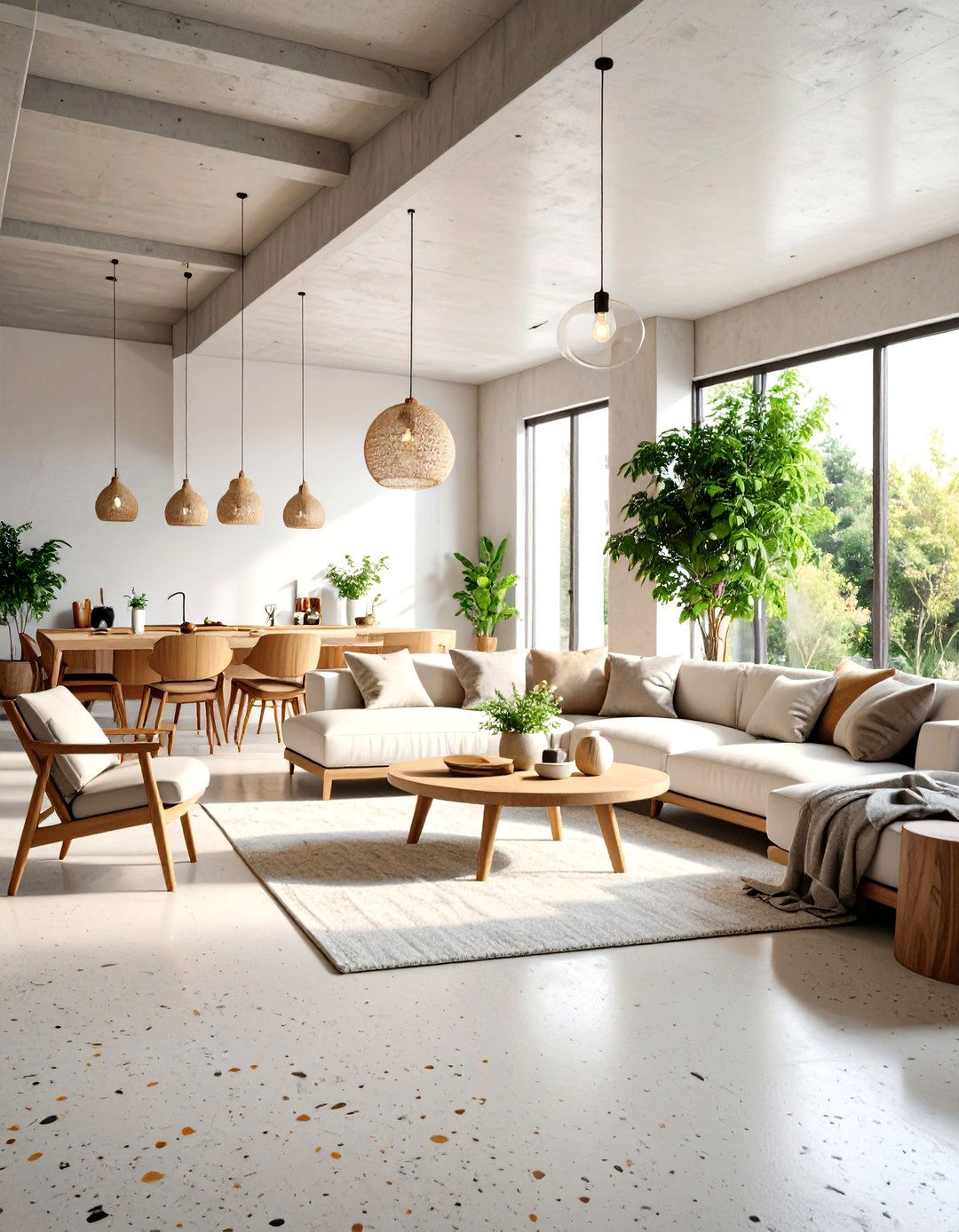
The commitment to sustainability continues to be a driving force in living room trends for 2025, with consumers prioritizing furniture and design ideas that minimize carbon footprints. This concrete floor living room philosophy emphasizes environmentally responsible design choices throughout the space. You can use manufactured materials such as recycled colored glass or even seashells and other interesting objects seeded into the concrete surface. Incorporate reclaimed wood furniture, recycled content in concrete mixes, and sustainable textiles to create environmentally conscious living spaces. Furniture from studios that collect leftover tiles and crush them to create speckled terrazzo-style furniture shows how sustainable practices create beautiful, eco-friendly solutions. Focus on local materials, energy-efficient lighting, and furnishings made from recycled or rapidly renewable resources that complement concrete's long lifespan and minimal maintenance requirements.
19. Indoor-Outdoor Flow Concrete Floor Living Room Concepts
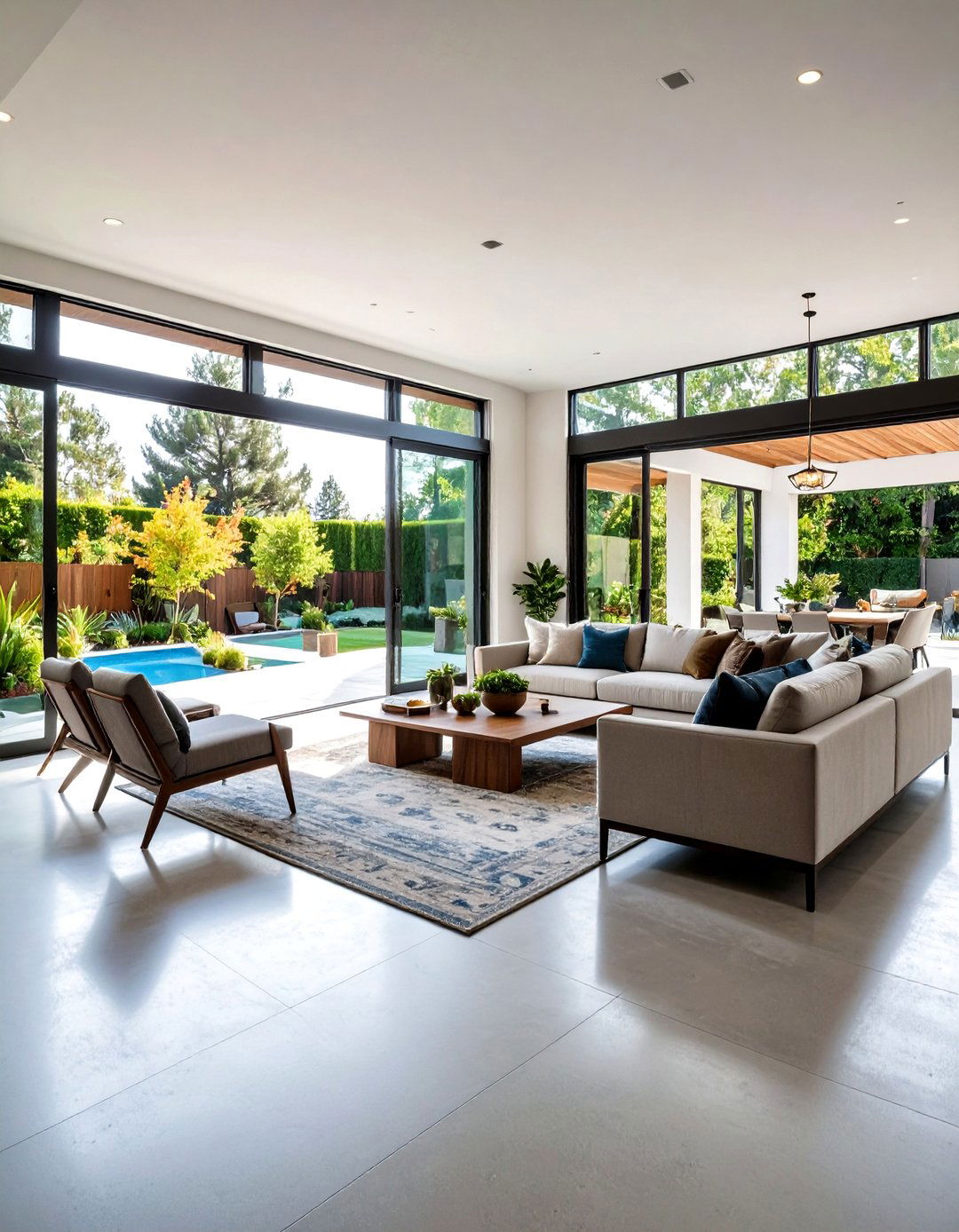
You can choose between subtly pulling outdoor materials inside or stretching the same flooring from your living room onto your terrace, making smaller spaces feel larger and more connected. This concrete floor living room design extends interior concrete finishes to outdoor patios, decks, or courtyards for seamless transitions. The outdoor patio, accessible through sliding glass doors, offers seamless transition between indoor and outdoor living with concrete flooring creating continuity. Use consistent concrete finishes, colors, and textures to blur boundaries between interior and exterior spaces. Polished concrete floors combined with accordion doors create indoor/outdoor design concepts perfect for entertaining and natural ventilation. Consider retractable glass walls, consistent furniture styles, and shared color palettes that make concrete floor living rooms feel connected to surrounding landscapes and outdoor entertainment areas.
20. Integrated Storage Concrete Floor Living Room Solutions
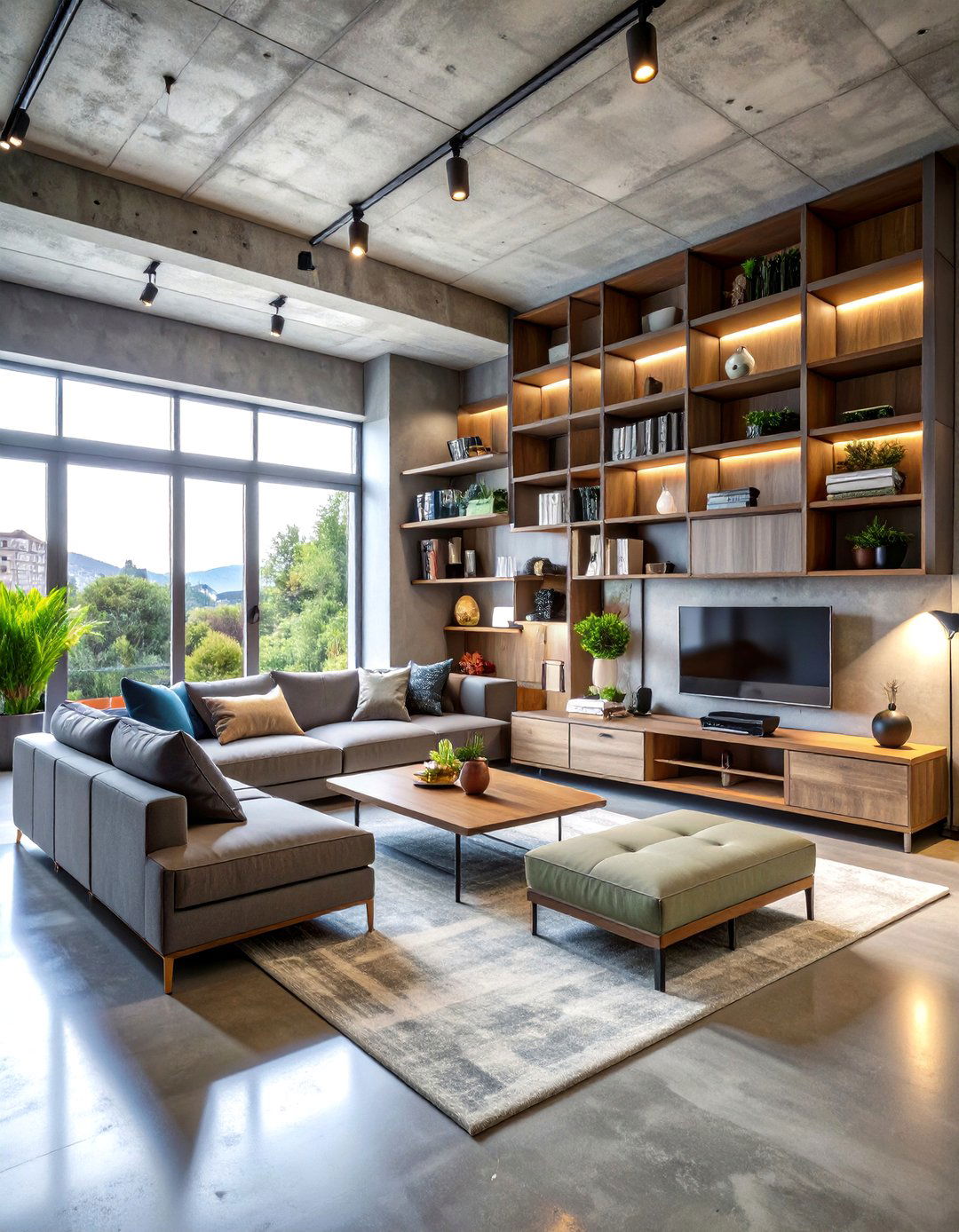
Because living rooms serve many purposes, you'll want to incorporate a variety of different furniture pieces to cover all possible activities, starting with storage solutions. This concrete floor living room concept integrates storage seamlessly into the architectural design while maintaining clean, uncluttered aesthetics. Custom cabinetry provides space for wall-mounted televisions and owners' collections while concealing unsightly electronic components. Consider concrete built-in shelving units, hidden storage benches, or integrated media centers that complement the material continuity. Start with big pieces like entertainment centers or TV stands to house electronics and accessories, or bookcases to keep books, picture frames and knickknacks organized. These storage solutions maintain the sophisticated appearance of concrete floor living rooms while providing practical organization for modern family life and entertainment needs.
Conclusion:
Concrete floor living rooms offer incredible versatility, combining practical benefits with sophisticated design possibilities that suit any lifestyle or budget. From polished surfaces that reflect light beautifully to textured aggregate finishes that add natural character, concrete provides the perfect foundation for creating distinctive, comfortable living spaces. Whether you prefer minimalist elegance, industrial chic, or cozy Scandinavian warmth, concrete floors adapt to your vision while providing energy efficiency, durability, and timeless appeal. These 20 ideas demonstrate how concrete's inherent neutrality allows for creative expression through furniture, lighting, textiles, and architectural details that transform ordinary spaces into extraordinary homes.



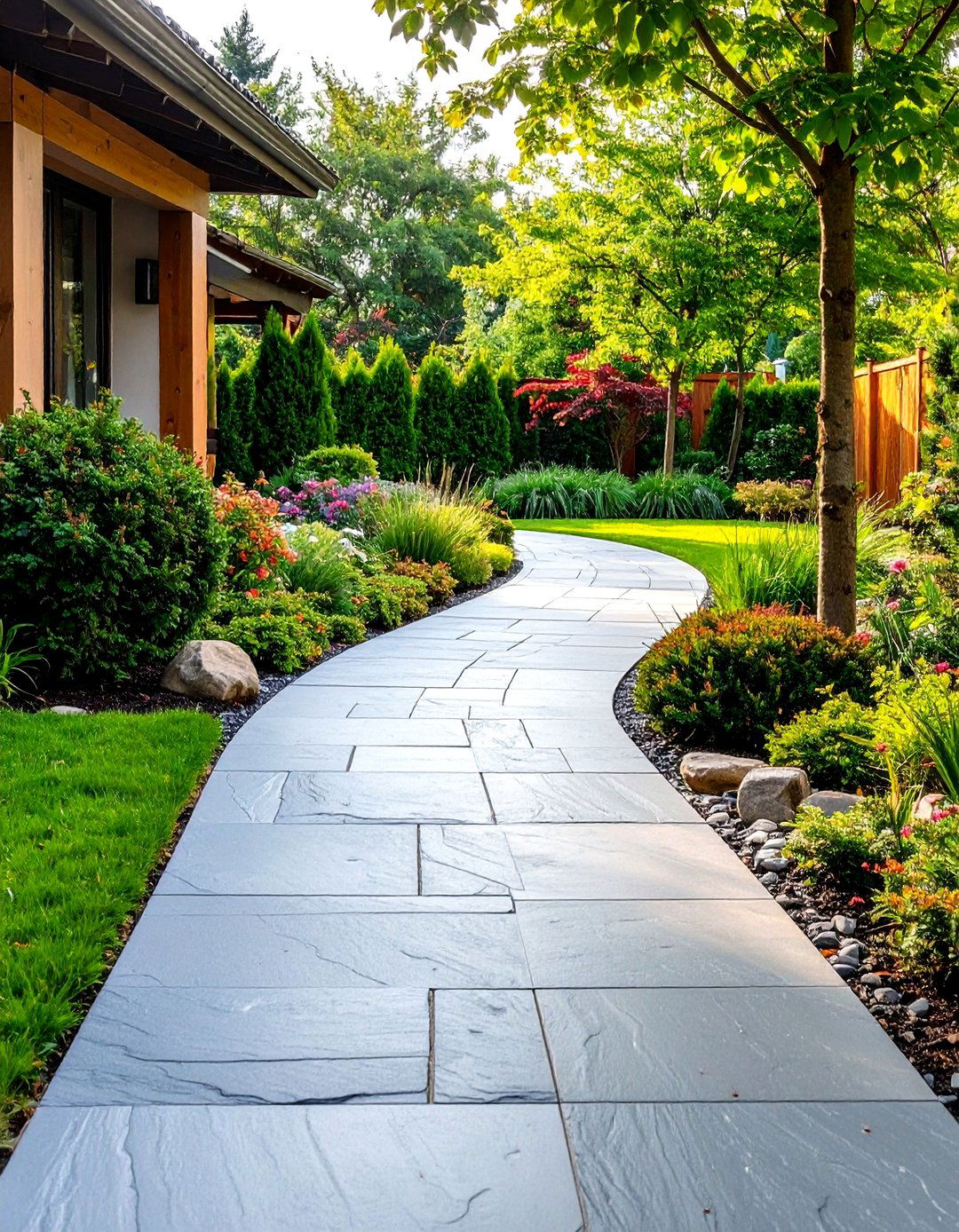
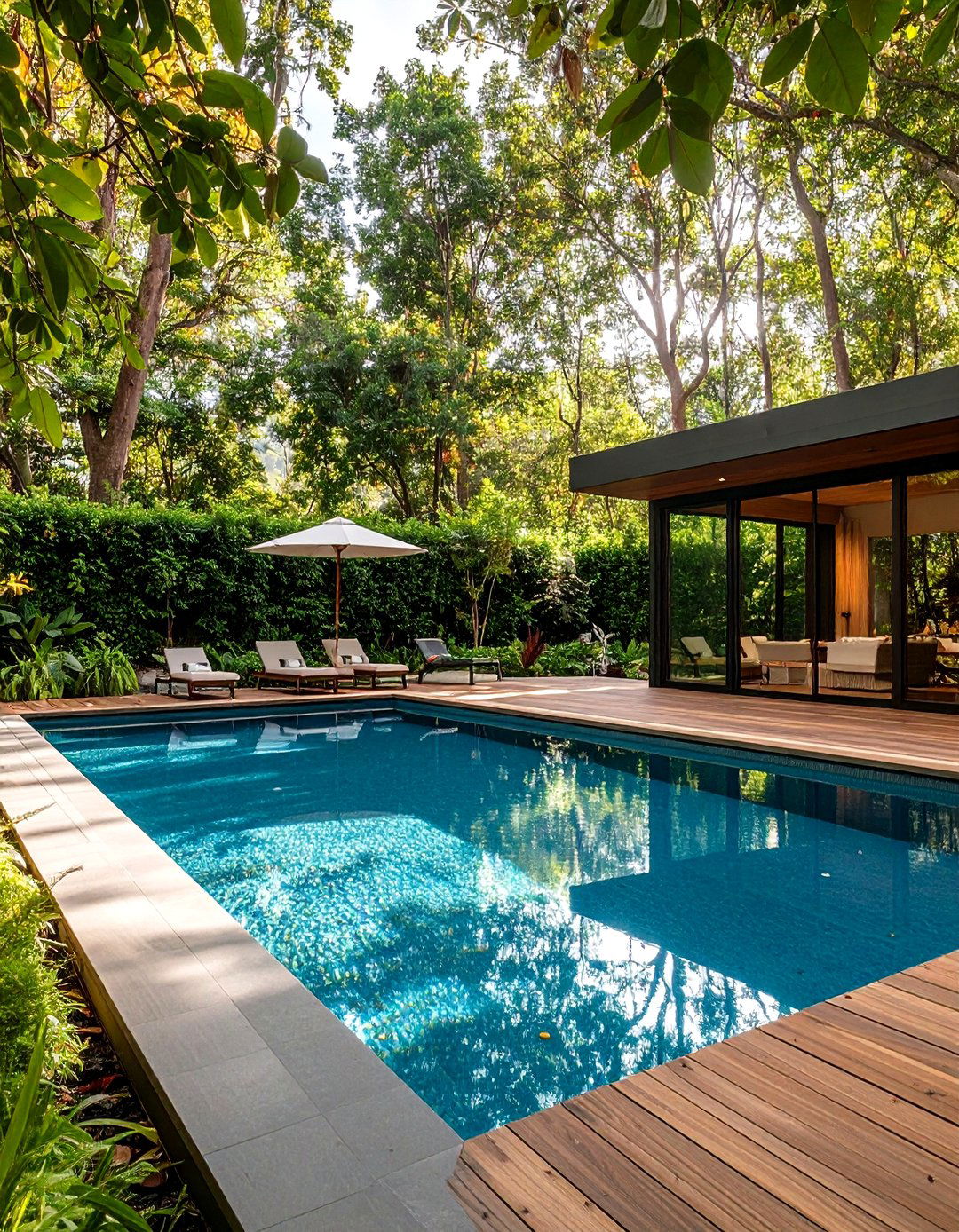
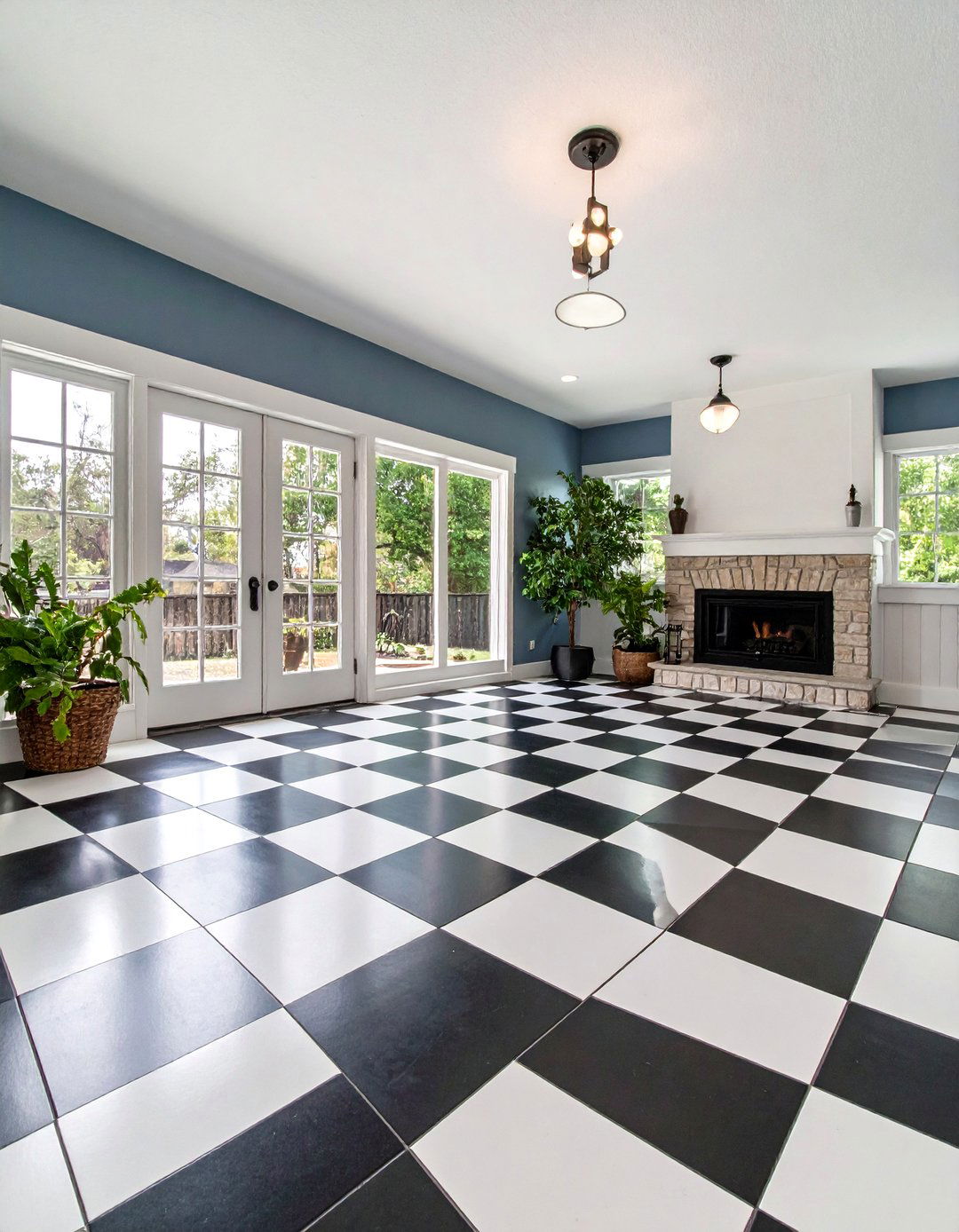

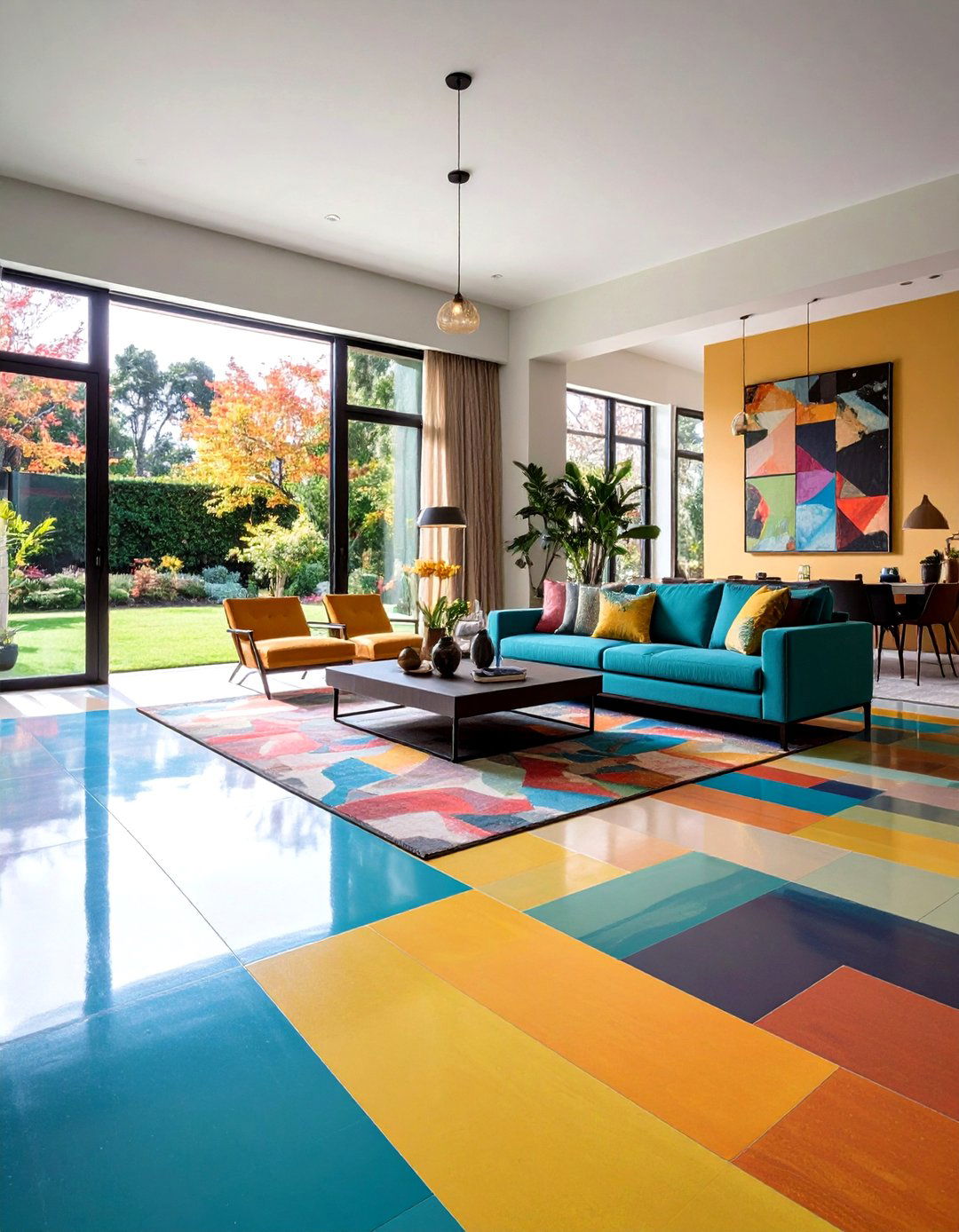
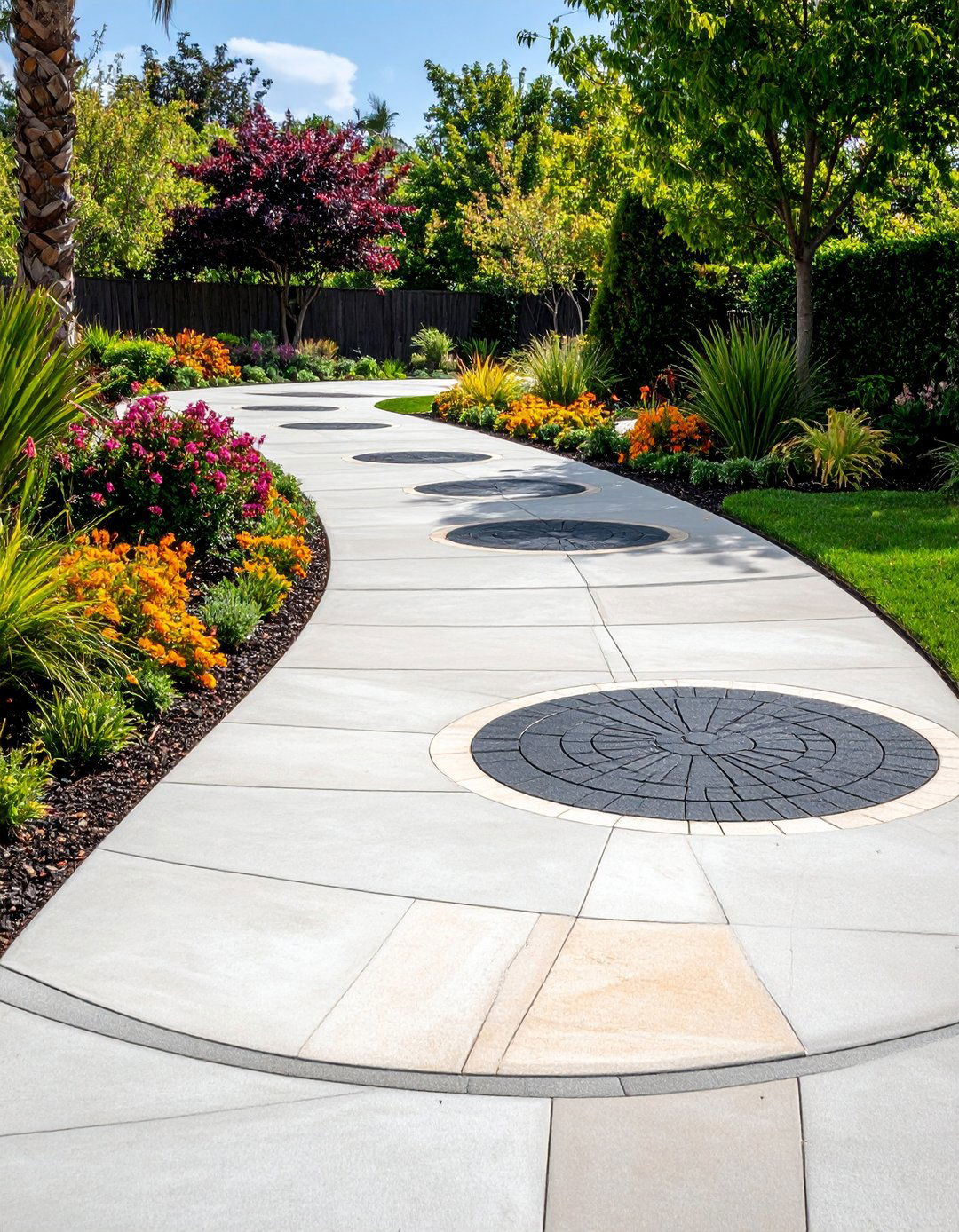
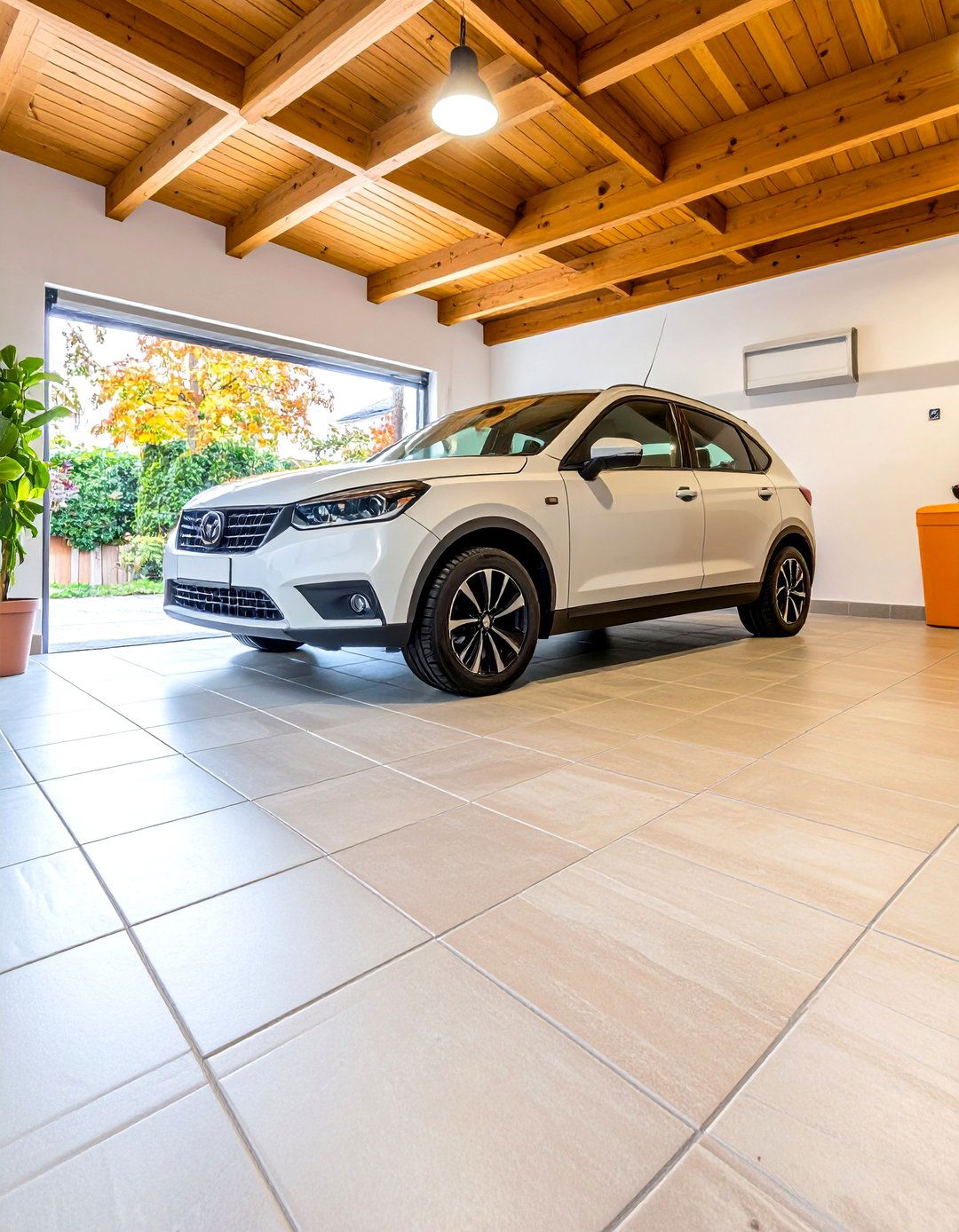
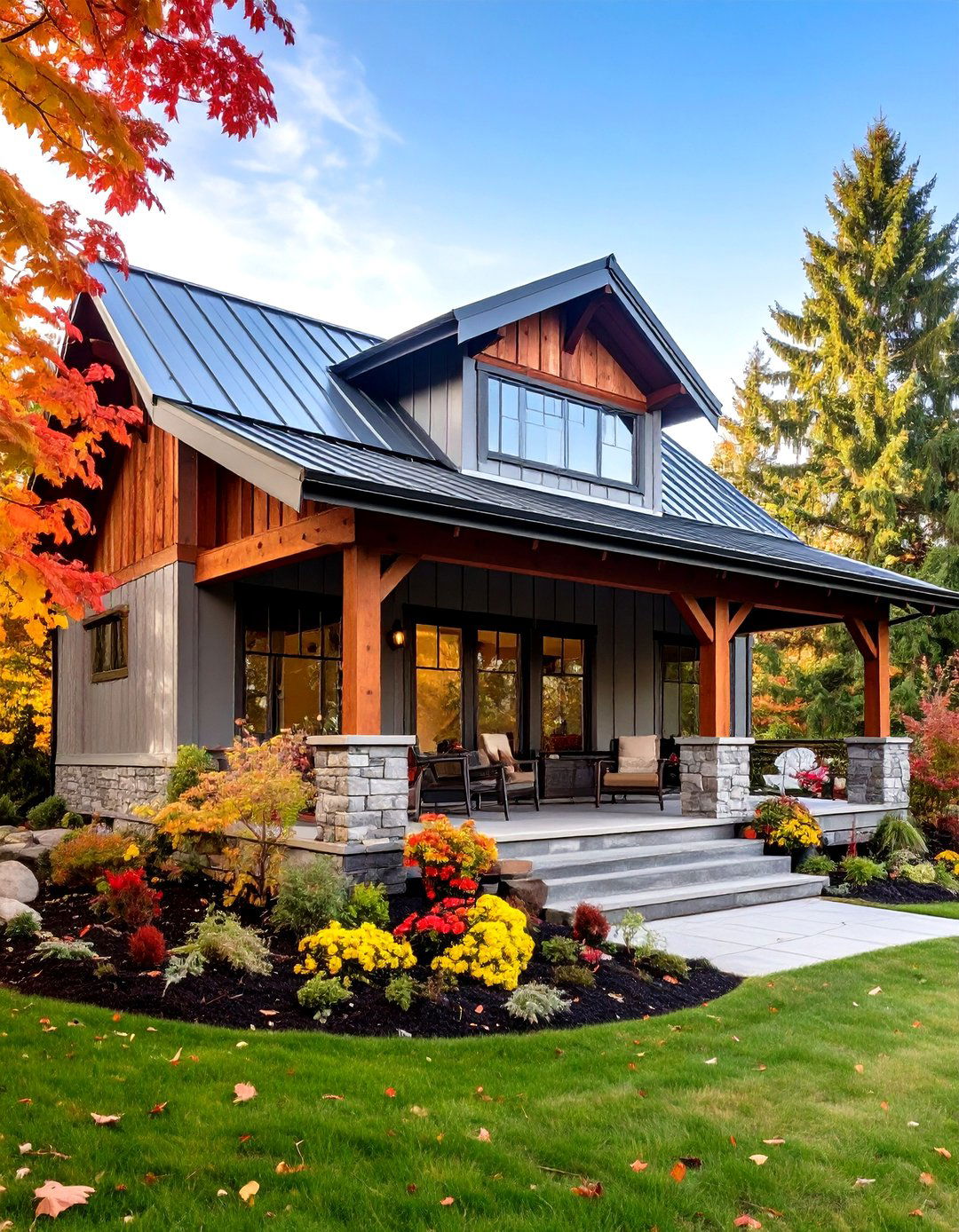
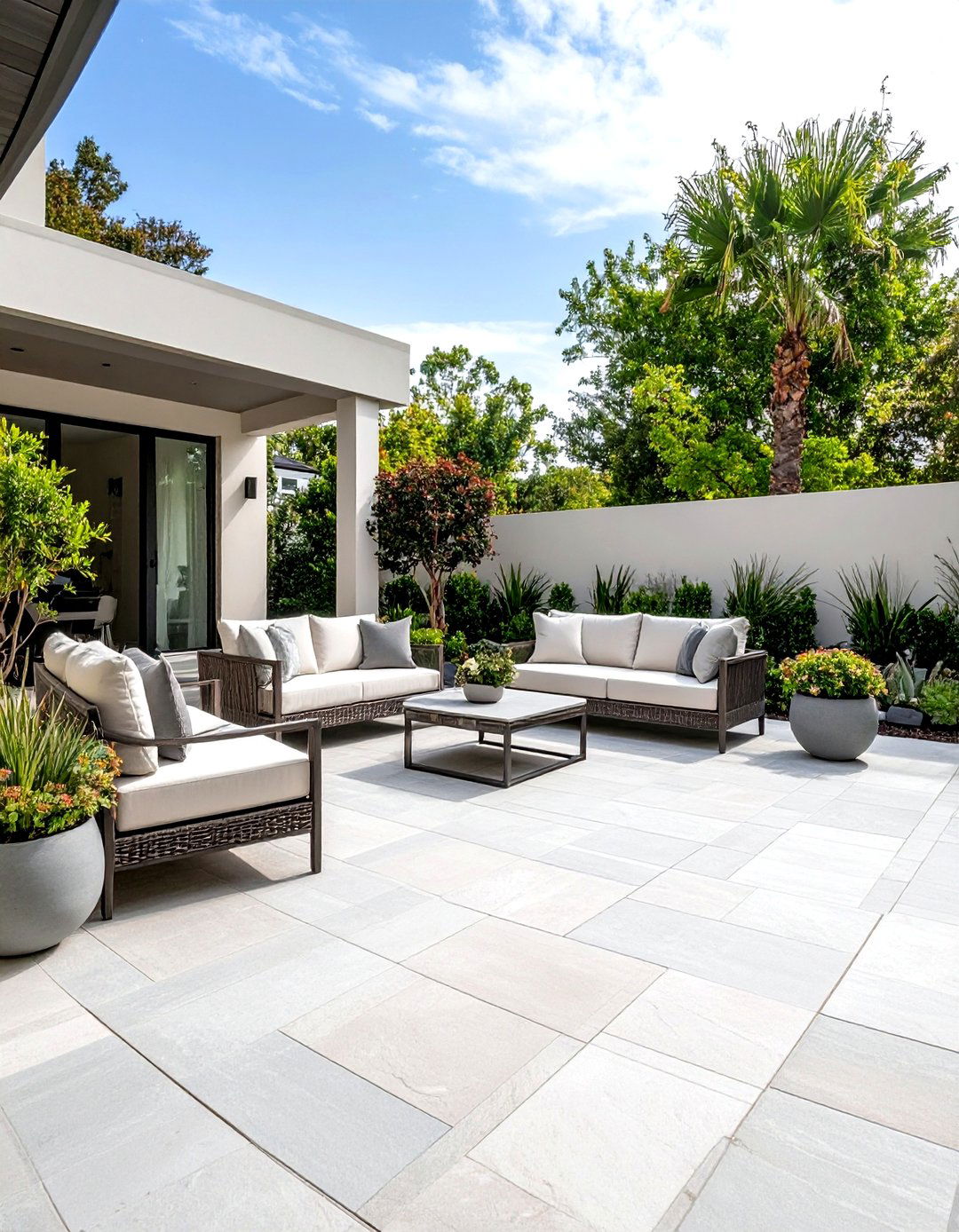
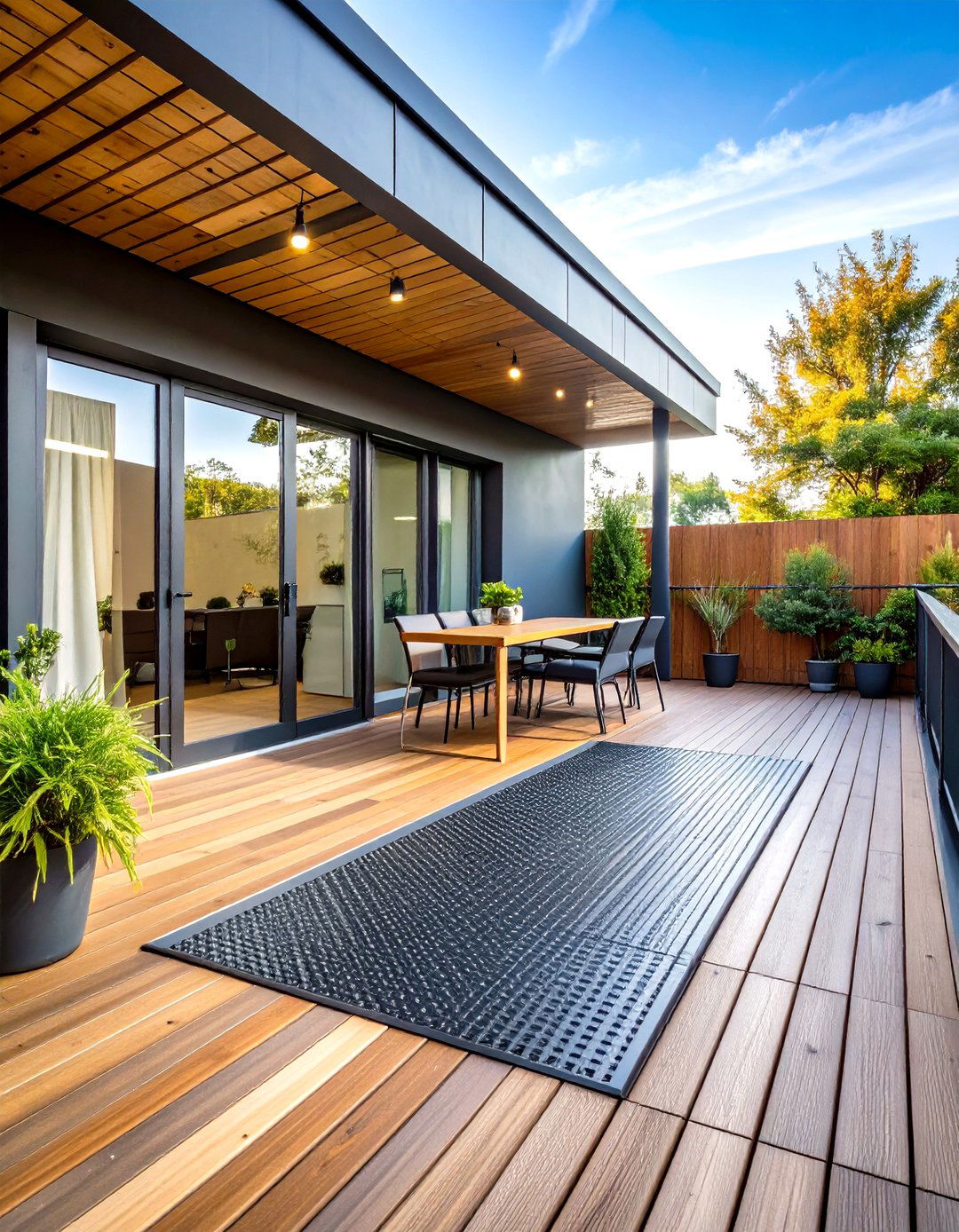
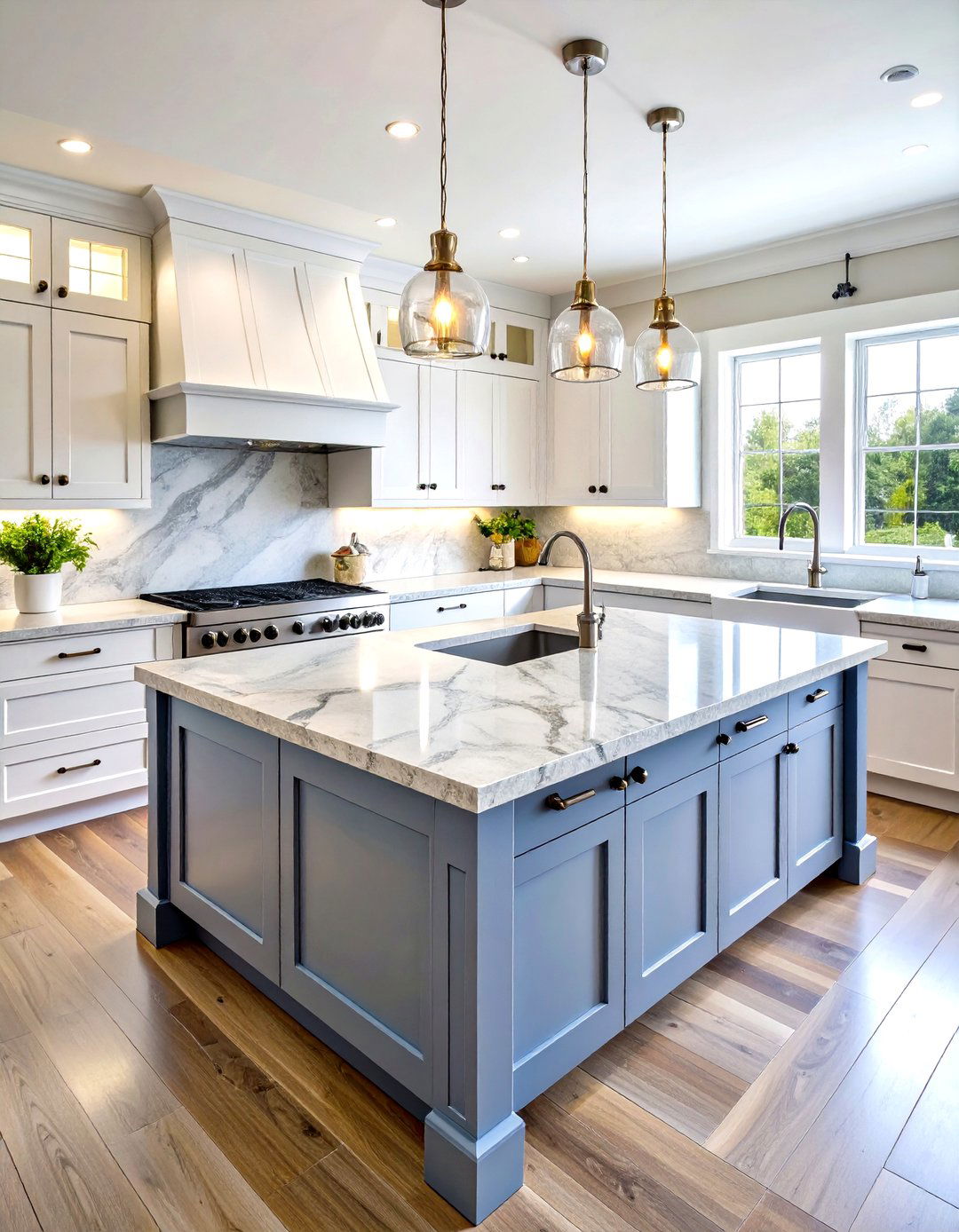
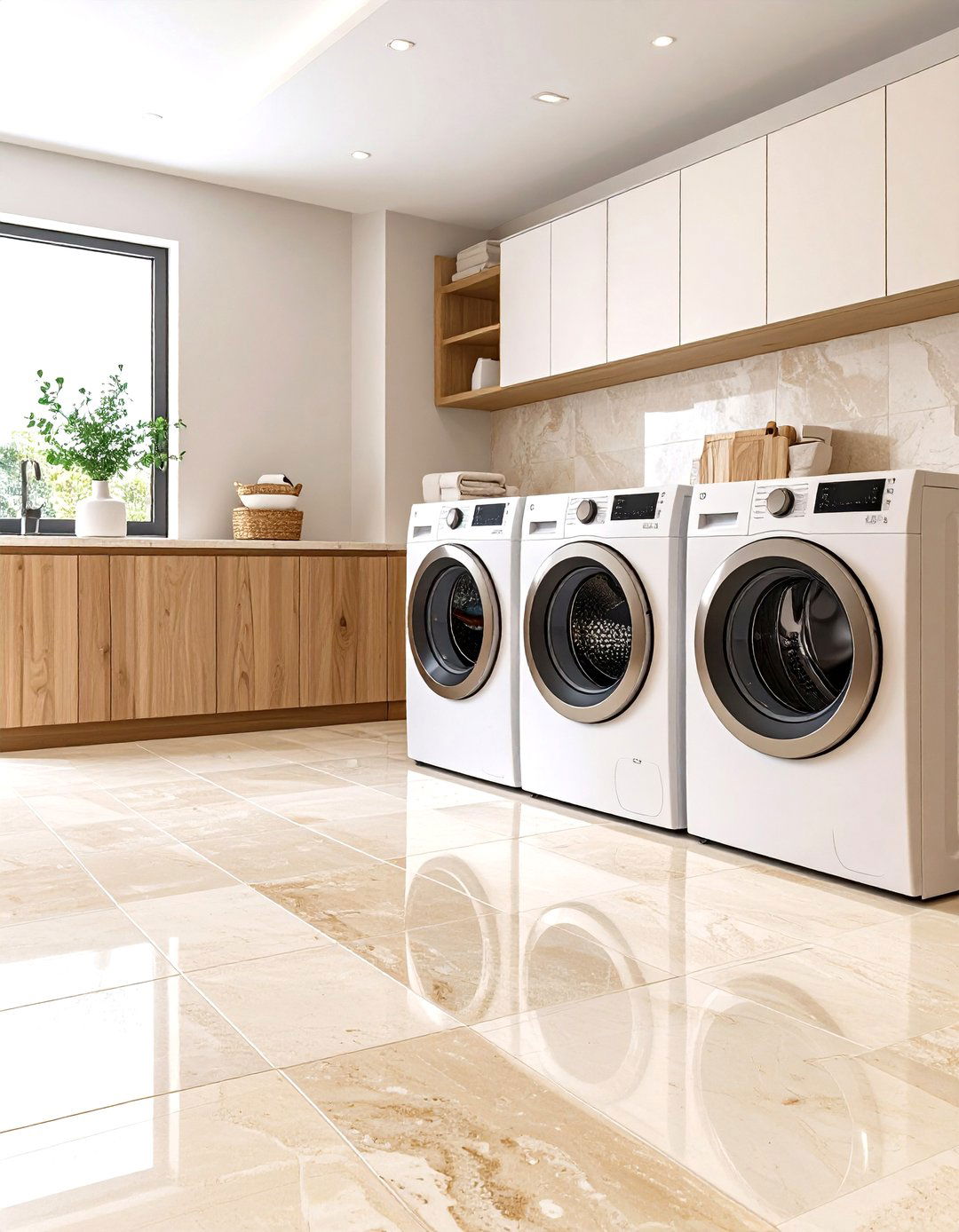
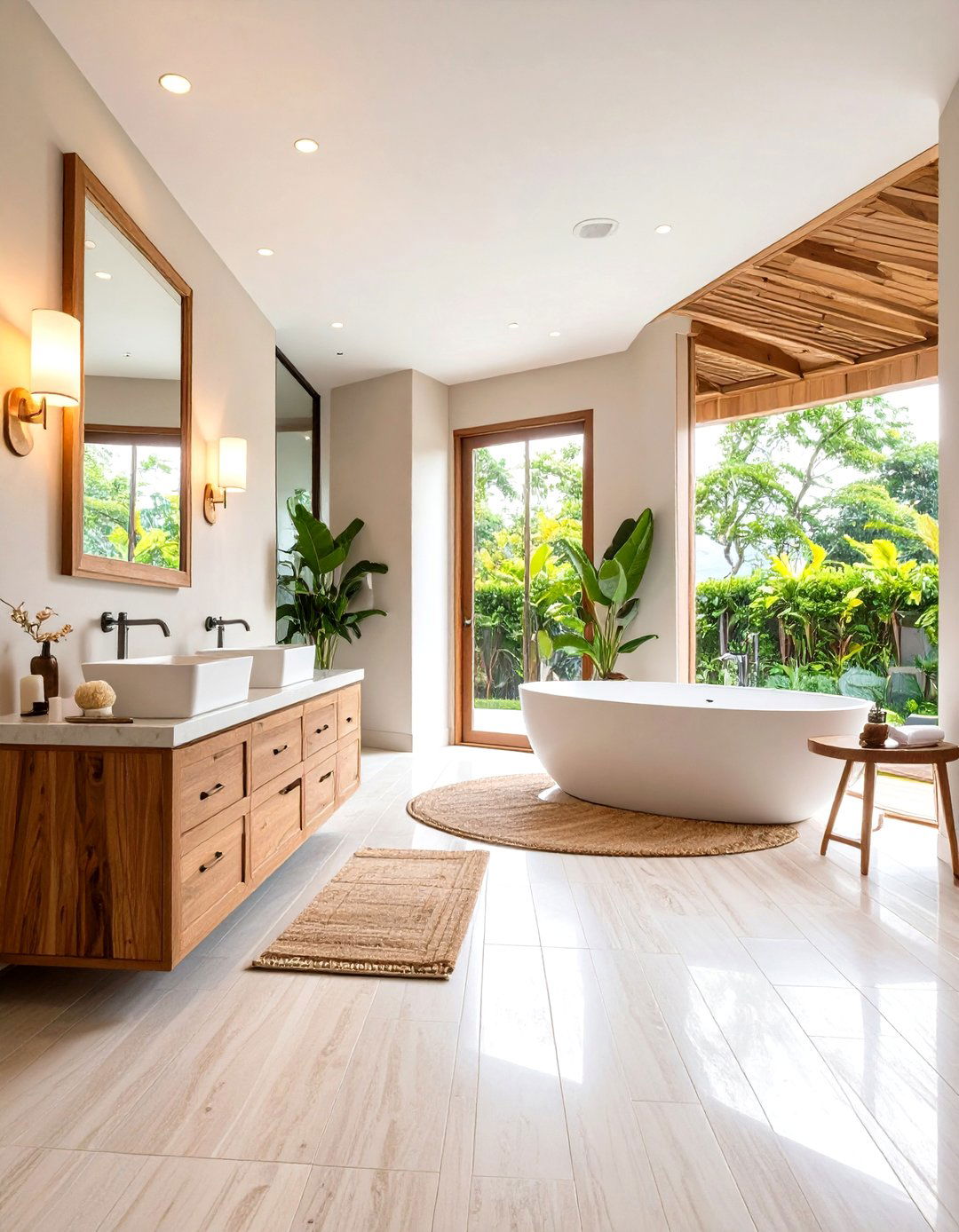
Leave a Reply